|
SNAP Library , Developer Reference
2013-01-07 14:03:36
SNAP, a general purpose, high performance system for analysis and manipulation of large networks
|
|
SNAP Library , Developer Reference
2013-01-07 14:03:36
SNAP, a general purpose, high performance system for analysis and manipulation of large networks
|
#include <mag.h>
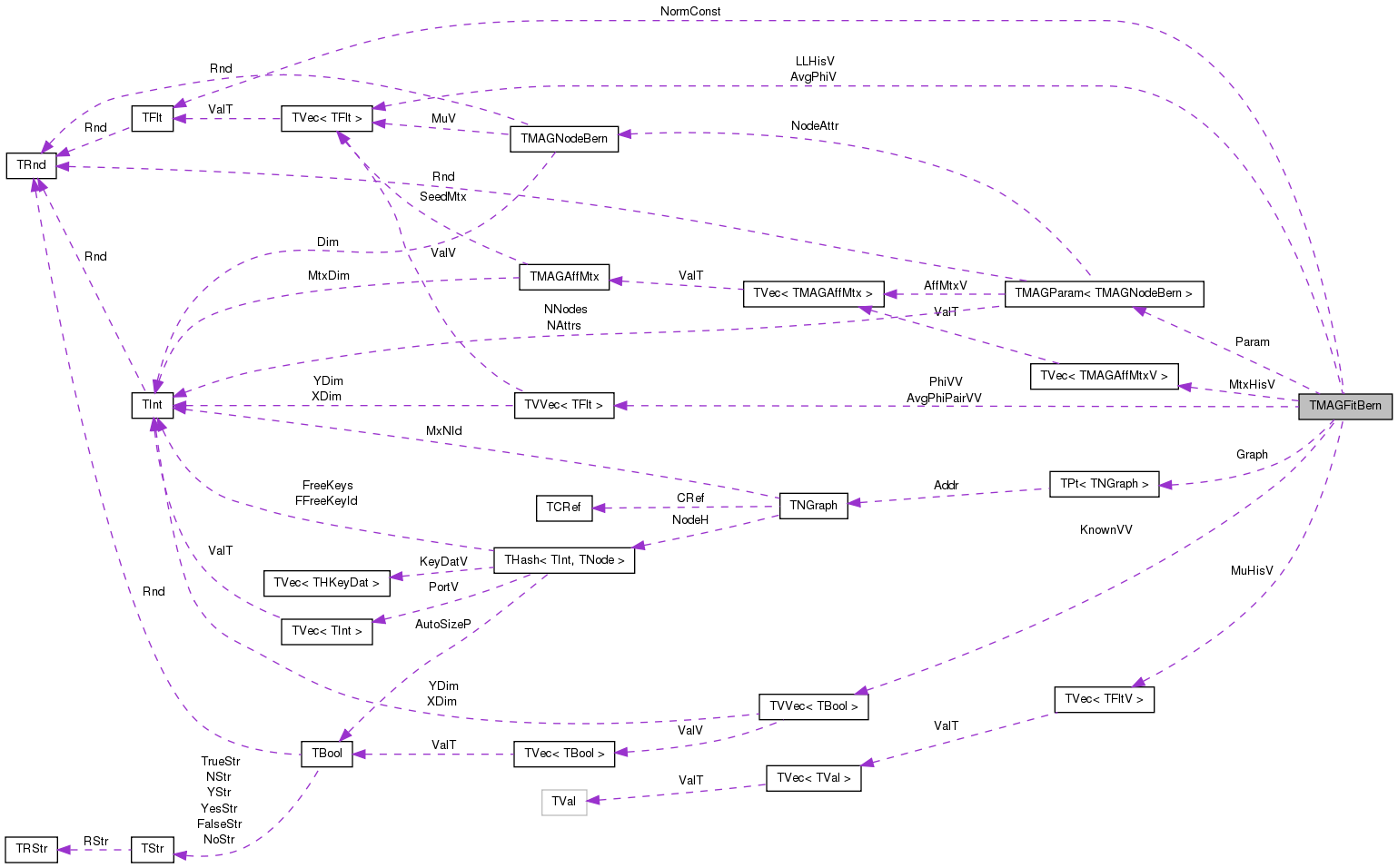
Public Member Functions | |
| TMAGFitBern () | |
| TMAGFitBern (const PNGraph &G, const int &NAttrs) | |
| TMAGFitBern (const PNGraph &G, const TStr &InitFNm) | |
| void | Clr () |
| void | SaveTxt (const TStr &FNm) |
| const int | GetNodes () const |
| const int | GetAttrs () const |
| const TMAGParam< TMAGNodeBern > & | GetParams () const |
| const TMAGNodeBern & | GetNodeAttr () const |
| const TFltV & | GetMuV () const |
| void | SetMuV (const TFltV &MuV) |
| void | GetMtxV (TMAGAffMtxV &MtxV) const |
| void | SetMtxV (const TMAGAffMtxV &MtxV) |
| PNGraph | GetGraph () |
| void | SetGraph (const PNGraph &GraphPt) |
| void | SetDebug (const bool _Debug) |
| void | SetAlgConf (const bool EStep=true, const bool MStep=true) |
| void | Init (const TFltV &MuV, const TMAGAffMtxV &AffMtxV) |
| void | RandomInit (const TFltV &MuV, const TMAGAffMtxV &AffMtxV, const int &Seed) |
| const TFltVV & | GetPhiVV () const |
| void | SetPhiVV (const TIntVV &AttrVV, const int KnownIds=0) |
| void | SetPhiVV (const TFltVV &AttrVV, const int KnownIds=0) |
| const double | GetInCoeff (const int &i, const int &j, const int &l, const int &A, const TMAGAffMtx &Theta) const |
| const double | GetAvgInCoeff (const int &i, const int &AId, const int &A, const TMAGAffMtx &Theta) const |
| const double | GetOutCoeff (const int &i, const int &j, const int &l, const int &A, const TMAGAffMtx &Theta) const |
| const double | GetAvgOutCoeff (const int &i, const int &AId, const int &A, const TMAGAffMtx &Theta) const |
| const double | GetProbPhi (const int &NId1, const int &NId2, const int &AId, const int &Attr1, const int &Attr2) const |
| const double | GetProbMu (const int &NId1, const int &NId2, const int &AId, const int &Attr1, const int &Attr2, const bool Left=false, const bool Right=false) const |
| const double | GetThetaLL (const int &NId1, const int &NId2, const int &AId) const |
| const double | GetAvgThetaLL (const int &NId1, const int &NId2, const int &AId, const bool Left=false, const bool Right=false) const |
| const double | GetSqThetaLL (const int &NId1, const int &NId2, const int &AId) const |
| const double | GetAvgSqThetaLL (const int &NId1, const int &NId2, const int &AId, const bool Left=false, const bool Right=false) const |
| const double | GetProdLinWeight (const int &NId1, const int &NId2) const |
| const double | GetAvgProdLinWeight (const int &NId1, const int &NId2, const bool Left=false, const bool Right=false) const |
| const double | GetProdSqWeight (const int &NId1, const int &NId2) const |
| const double | GetAvgProdSqWeight (const int &NId1, const int &NId2, const bool Left=false, const bool Right=false) const |
| const double | GetEstNoEdgeLL (const int &NId, const int &AId) const |
| const double | GradPhiMI (const double &x, const int &NId, const int &AId, const double &Lambda, const double &DeltaQ, const TFltVV &CntVV) |
| const double | ObjPhiMI (const double &x, const int &NId, const int &AId, const double &Lambda, const double &Q0, const double &Q1, const TFltVV &CntVV) |
| const double | UpdatePhiMI (const double &Lambda, const int &NId, const int &AId, double &Phi) |
| const double | UpdateApxPhiMI (const double &Lambda, const int &NId, const int &AId, double &Phi, TFltVV &ProdVV) |
| const double | UpdatePhi (const int &NId, const int &AId, double &Phi) |
| const double | UpdateMu (const int &AId) |
| const void | PrepareUpdateAffMtx (TFltVV &ProdVV, TFltVV &SqVV) |
| const void | PrepareUpdateApxAffMtx (TFltVV &ProdVV, TFltVV &SqVV) |
| const double | UpdateAffMtx (const int &AId, const double &LrnRate, const double &MaxGrad, const double &Lambda, TFltVV &ProdVV, TFltVV &SqVV, TMAGAffMtx &NewMtx) |
| const double | UpdateAffMtxV (const int &GradIter, const double &LrnRate, const double &MaxGrad, const double &Lambda, const int &NReal=0) |
| const void | GradAffMtx (const int &AId, const TFltVV &ProdVV, const TFltVV &SqVV, const TMAGAffMtx &CurMtx, TFltV &GradV) |
| const void | GradApxAffMtx (const int &AId, const TFltVV &ProdVV, const TFltVV &SqVV, const TMAGAffMtx &CurMtx, TFltV &GradV) |
| double | DoEStepOneIter (const TFltV &TrueMuV, TFltVV &NewPhi, const double &Lambda) |
| double | DoEStepApxOneIter (const TFltV &TrueMuV, TFltVV &NewPhi, const double &Lambda) |
| double | DoEStep (const TFltV &TrueMuV, const int &NIter, double &LL, const double &Lambda) |
| void | DoMStep (const int &GradIter, const double &LrnRate, const double &MaxGrad, const double &Lambda, const int &NReal=0) |
| void | DoEMAlg (const int &NStep, const int &NEstep, const int &NMstep, const double &LrnRate, const double &MaxGrad, const double &Lambda, const double &ReInit, const int &NReal=0) |
| void | CountAttr (TFltV &EstMuV) const |
| void | SortAttrOrdering (const TFltV &TrueMuV, TIntV &IndexV) const |
| const double | ComputeJointOneLL (const TIntVV &AttrVV) const |
| const double | ComputeJointLL (int NSample) const |
| const double | ComputeJointAdjLL (const TIntVV &AttrVV) const |
| const double | ComputeApxLL () const |
| const double | ComputeApxAdjLL () const |
| void | MakeCCDF (const TFltPrV &RawV, TFltPrV &CcdfV) |
| void | PlotProperties (const TStr &FNm) |
| void | NormalizeAffMtxV (TMAGAffMtxV &MtxV, const bool UseMu=false) |
| void | UnNormalizeAffMtxV (TMAGAffMtxV &MtxV, const bool UseMu=false) |
Static Public Member Functions | |
| static const double | ComputeMI (const TIntVV &AttrV, const int AId1, const int AId2) |
| static const double | ComputeMI (const TFltVV &AttrV, const int AId1, const int AId2) |
| static const double | ComputeMI (const TIntVV &AttrV) |
| static const double | ComputeMI (const TFltVV &AttrV) |
Private Member Functions | |
| const bool | NextPermutation (TIntV &IndexV) const |
Private Attributes | |
| TFltVV | PhiVV |
| TBoolVV | KnownVV |
| PNGraph | Graph |
| TMAGParam< TMAGNodeBern > | Param |
| bool | ESpeedUp |
| bool | MSpeedUp |
| bool | Debug |
| TFltV | AvgPhiV |
| TFltVV | AvgPhiPairVV |
| TFlt | NormConst |
| TVec< TFltV > | MuHisV |
| TVec< TMAGAffMtxV > | MtxHisV |
| TFltV | LLHisV |
| TMAGFitBern::TMAGFitBern | ( | ) | [inline] |
| TMAGFitBern::TMAGFitBern | ( | const PNGraph & | G, |
| const int & | NAttrs | ||
| ) | [inline] |
| TMAGFitBern::TMAGFitBern | ( | const PNGraph & | G, |
| const TStr & | InitFNm | ||
| ) | [inline] |
Definition at line 360 of file mag.h.
References AvgPhiPairVV, AvgPhiV, TVec< TVal >::Gen(), TVVec< TVal >::Gen(), TMAGParam< TNodeAttr >::GetAttrs(), TNGraph::GetNodes(), KnownVV, Param, PhiVV, and SetGraph().
: Param(G->GetNodes(), InitFNm), ESpeedUp(true), MSpeedUp(true), Debug(false), NormConst(1.0) { const int NNodes = G->GetNodes(); const int NAttrs = Param.GetAttrs(); printf("NAttrs = %d\n", NAttrs); SetGraph(G); PhiVV.Gen(NNodes, NAttrs); KnownVV.Gen(NNodes, NAttrs); AvgPhiV.Gen(NAttrs); AvgPhiPairVV.Gen(NAttrs, NAttrs); }
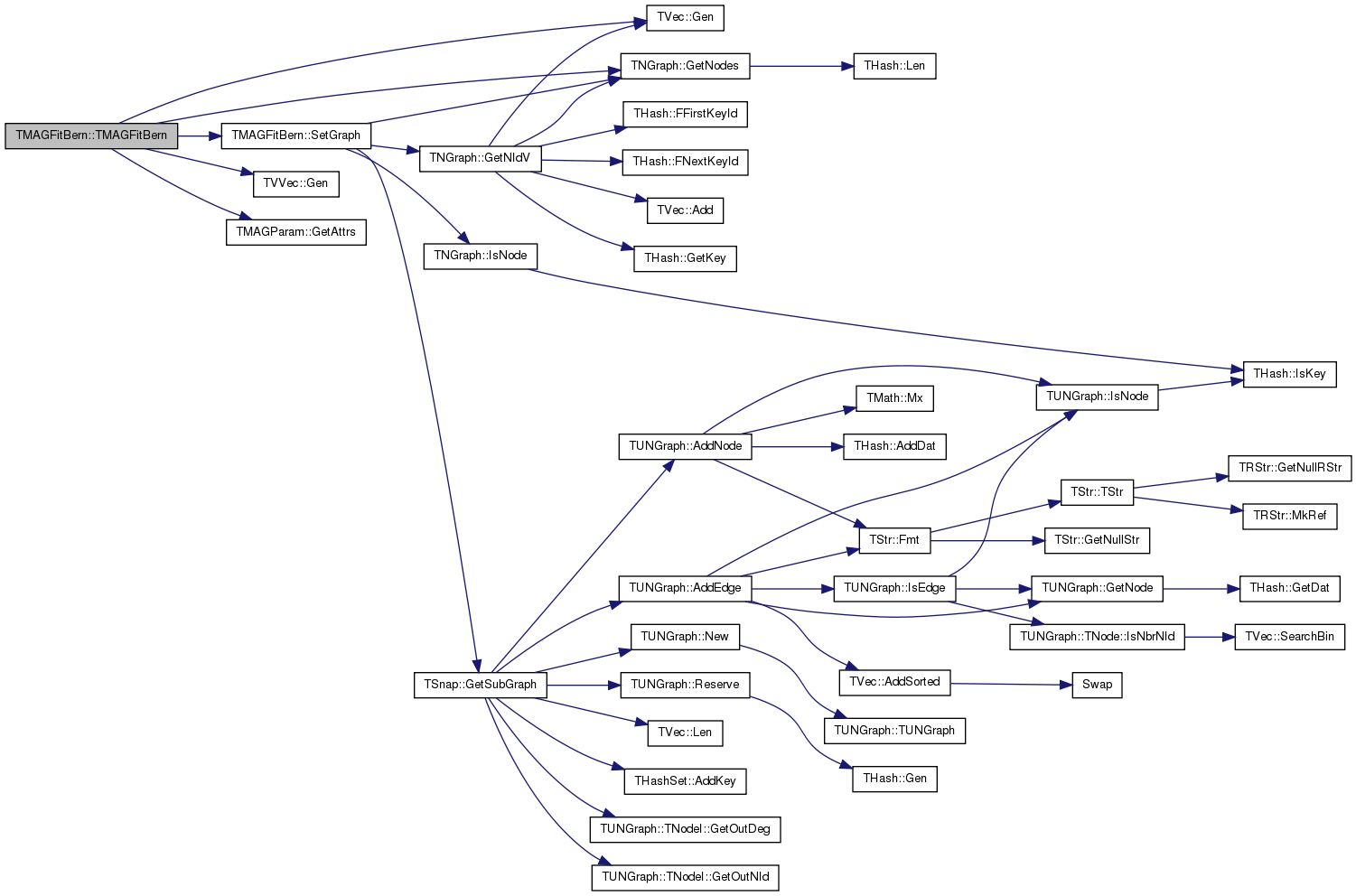
| void TMAGFitBern::Clr | ( | ) | [inline] |
| const double TMAGFitBern::ComputeApxAdjLL | ( | ) | const |
Definition at line 2046 of file mag.cpp.
References TMAGAffMtx::At(), TMAGParam< TNodeAttr >::GetAttrs(), TMAGAffMtx::GetLLMtx(), TMAGParam< TNodeAttr >::GetMtx(), TMAGNodeBern::GetMuV(), TMAGParam< TNodeAttr >::GetNodeAttr(), TMAGParam< TNodeAttr >::GetNodes(), GetProbPhi(), GetProdLinWeight(), Graph, TNGraph::IsEdge(), Param, PhiVV, and TVec< TVal >::PutAll().
{
double LL = 0.0;
// double LLSelf = 0.0;
const int NNodes = Param.GetNodes();
const int NAttrs = Param.GetAttrs();
TMAGNodeBern NodeAttr = Param.GetNodeAttr();
TFltV MuV = NodeAttr.GetMuV();
MuV.PutAll(0.0);
TMAGAffMtxV LLMtxV(NAttrs);
double TotalEdge = 0.0;
for(int l = 0; l < NAttrs; l++) {
TMAGAffMtx Theta = Param.GetMtx(l);
Theta.GetLLMtx(LLMtxV[l]);
}
for(int i = 0; i < NNodes; i++) {
for(int j = 0; j < NNodes; j++) {
if(i == j) { continue; }
if(Graph->IsEdge(i, j)) {
for(int l = 0; l < NAttrs; l++) {
LL += GetProbPhi(i, j, l, 0, 0) * LLMtxV[l].At(0, 0);
LL += GetProbPhi(i, j, l, 0, 1) * LLMtxV[l].At(0, 1);
LL += GetProbPhi(i, j, l, 1, 0) * LLMtxV[l].At(1, 0);
LL += GetProbPhi(i, j, l, 1, 1) * LLMtxV[l].At(1, 1);
}
} else {
LL += log(1-exp(GetProdLinWeight(i, j)));
}
double TempLL = 1.0;
for(int l = 0; l < NAttrs; l++) {
int Ai = (double(PhiVV(i, l)) > 0.5) ? 0 : 1;
int Aj = (double(PhiVV(j, l)) > 0.5) ? 0 : 1;
TempLL *= Param.GetMtx(l).At(Ai, Aj);
}
if(TMAGNodeBern::Rnd.GetUniDev() < TempLL) {
TotalEdge += 1.0;
}
}
}
return LL;
}
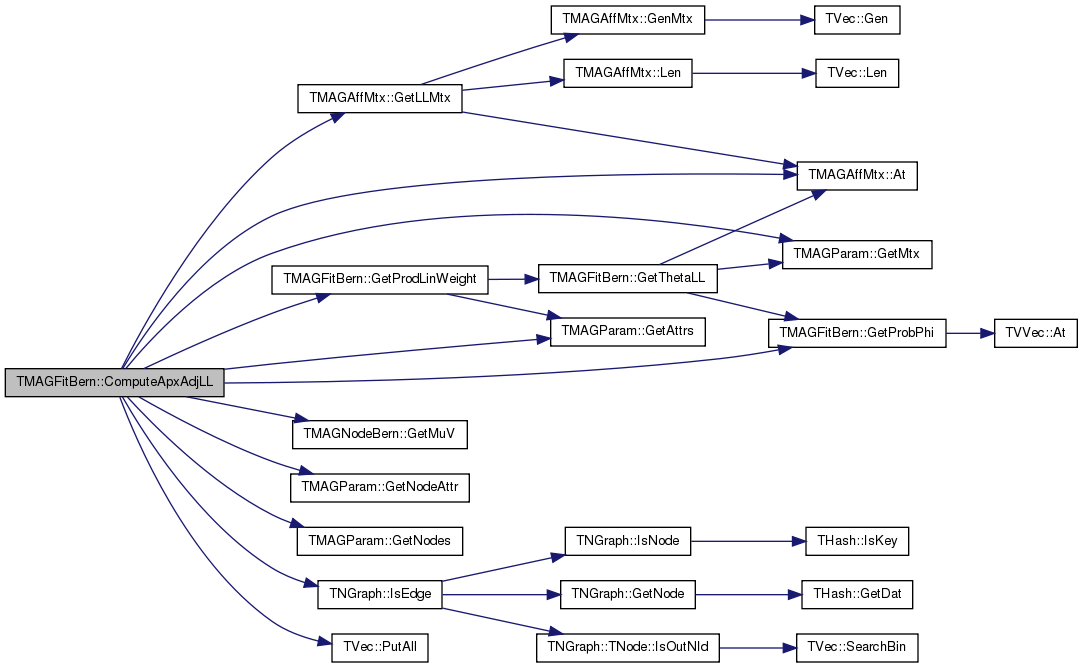
| const double TMAGFitBern::ComputeApxLL | ( | ) | const |
Definition at line 2005 of file mag.cpp.
References TMAGParam< TNodeAttr >::GetAttrs(), TMAGAffMtx::GetLLMtx(), TMAGParam< TNodeAttr >::GetMtx(), TMAGNodeBern::GetMuV(), TMAGParam< TNodeAttr >::GetNodeAttr(), TMAGParam< TNodeAttr >::GetNodes(), GetProbPhi(), GetProdLinWeight(), Graph, TNGraph::IsEdge(), NormConst, Param, and PhiVV.
Referenced by DoEMAlg().
{
double LL = 0.0;
// double LLSelf = 0.0;
const int NNodes = Param.GetNodes();
const int NAttrs = Param.GetAttrs();
TMAGNodeBern NodeAttr = Param.GetNodeAttr();
TFltV MuV = NodeAttr.GetMuV();
TMAGAffMtxV LLMtxV(NAttrs);
for(int l = 0; l < NAttrs; l++) {
for(int i = 0; i < NNodes; i++) {
LL += PhiVV(i, l) * log(MuV[l]);
LL += (1.0 - PhiVV(i, l)) * log(1.0 - MuV[l]);
LL -= PhiVV(i, l) * log(PhiVV(i, l));
LL -= (1.0 - PhiVV(i, l)) * log(1.0 - PhiVV(i, l));
}
TMAGAffMtx Theta = Param.GetMtx(l);
Theta.GetLLMtx(LLMtxV[l]);
}
for(int i = 0; i < NNodes; i++) {
for(int j = 0; j < NNodes; j++) {
if(i == j) { continue; }
if(Graph->IsEdge(i, j)) {
for(int l = 0; l < NAttrs; l++) {
LL += GetProbPhi(i, j, l, 0, 0) * LLMtxV[l].At(0, 0);
LL += GetProbPhi(i, j, l, 0, 1) * LLMtxV[l].At(0, 1);
LL += GetProbPhi(i, j, l, 1, 0) * LLMtxV[l].At(1, 0);
LL += GetProbPhi(i, j, l, 1, 1) * LLMtxV[l].At(1, 1);
}
LL += log(NormConst);
} else {
LL += log(1-exp(GetProdLinWeight(i, j)));
}
}
}
return LL;
}
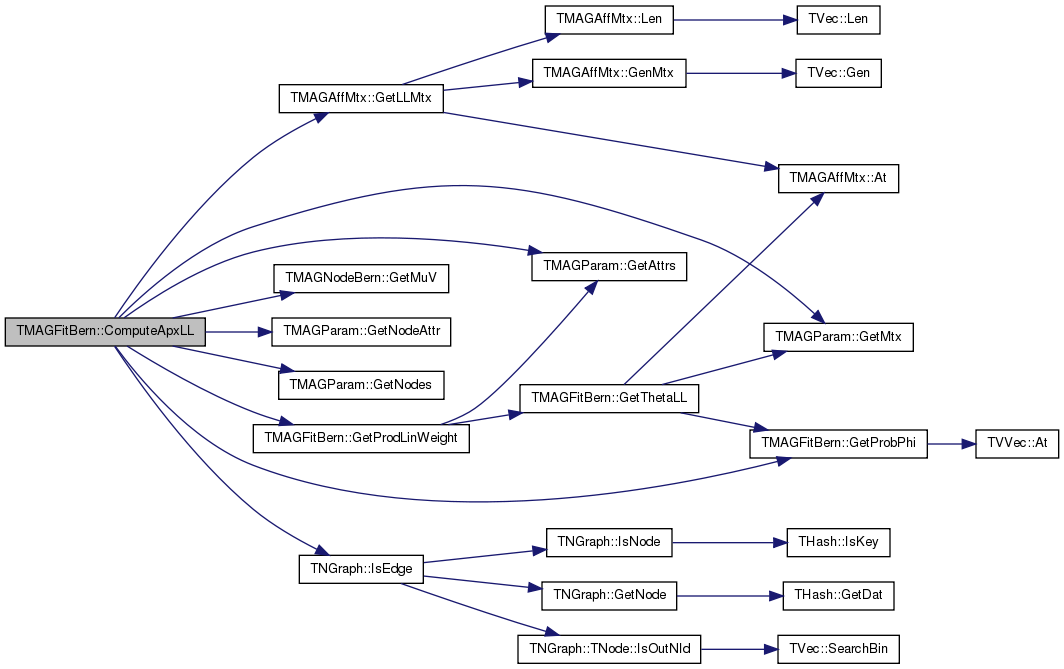

| const double TMAGFitBern::ComputeJointAdjLL | ( | const TIntVV & | AttrVV | ) | const |
Definition at line 1942 of file mag.cpp.
References TVVec< TVal >::At(), TMAGParam< TNodeAttr >::GetAttrs(), TMAGParam< TNodeAttr >::GetMtxV(), TMAGNodeBern::GetMuV(), TMAGParam< TNodeAttr >::GetNodeAttr(), TMAGParam< TNodeAttr >::GetNodes(), Graph, TNGraph::IsEdge(), TVec< TVal >::Len(), and Param.
{
double LL = 0.0;
const int NNodes = Param.GetNodes();
const int NAttrs = Param.GetAttrs();
TMAGAffMtxV MtxV(NAttrs); Param.GetMtxV(MtxV);
const TMAGNodeBern NodeAttr = Param.GetNodeAttr();
const TFltV MuV = NodeAttr.GetMuV();
for(int l = 0; l < NAttrs; l++) {
for(int i = 0; i < MtxV[l].Len(); i++) {
MtxV[l].At(i) = log(MtxV[l].At(i));
}
}
for(int i = 0; i < NNodes; i++) {
for(int j = 0; j < NNodes; j++) {
if(i == j) { continue; }
double ProbLL = 0.0;
for(int l = 0; l < NAttrs; l++) {
ProbLL += MtxV[l].At(AttrVV.At(i, l), AttrVV.At(j, l));
}
if(Graph->IsEdge(i, j)) {
LL += ProbLL;
} else {
LL += log(1-exp(ProbLL));
}
}
}
return LL;
}
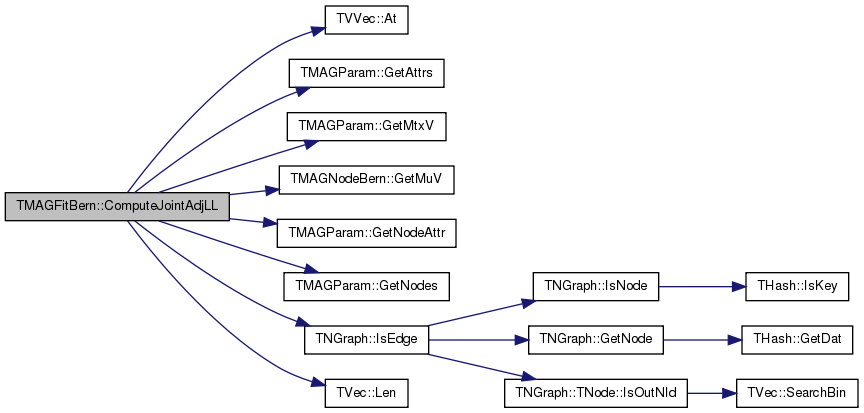
| const double TMAGFitBern::ComputeJointLL | ( | int | NSample | ) | const |
Definition at line 1976 of file mag.cpp.
References TVVec< TVal >::At(), TVVec< TVal >::Clr(), ComputeJointOneLL(), TMAGParam< TNodeAttr >::GetAttrs(), TMAGParam< TNodeAttr >::GetNodes(), TRnd::GetUniDev(), Param, and PhiVV.
{
double LL = 0.0;
const int NNodes = Param.GetNodes();
const int NAttrs = Param.GetAttrs();
TRnd Rnd(2000);
TIntVV AttrVV(NNodes, NAttrs);
int count = 0;
for(int s = 0; s < NSample; s++) {
for(int i = 0; i < NNodes; i++) {
for(int l = 0; l < NAttrs; l++) {
if(Rnd.GetUniDev() <= PhiVV(i, l)) {
AttrVV.At(i, l) = 0;
} else {
AttrVV.At(i, l) = 1;
}
if(PhiVV(i, l) > 0.05 && PhiVV(i, l) < 0.95) count++;
}
}
LL += ComputeJointOneLL(AttrVV);
}
AttrVV.Clr();
return LL / double(NSample);
}
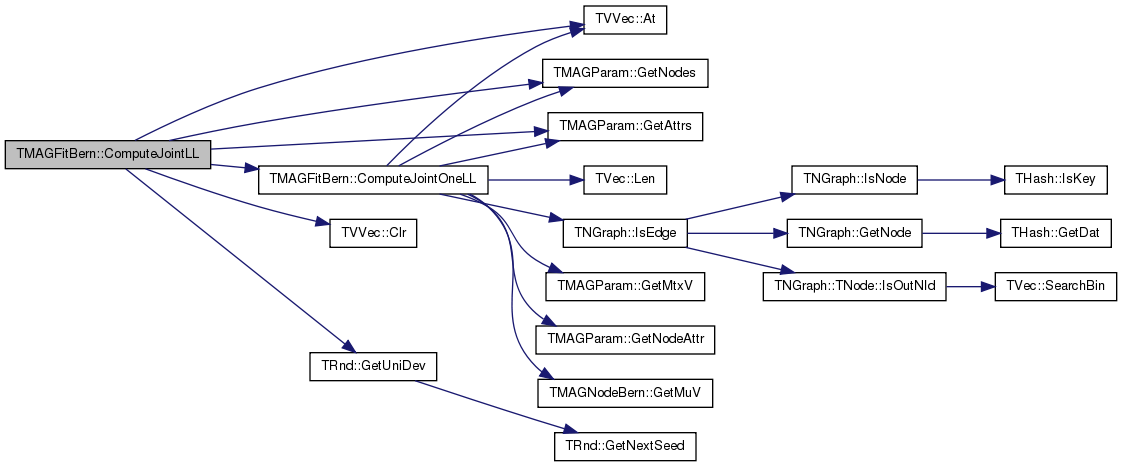
| const double TMAGFitBern::ComputeJointOneLL | ( | const TIntVV & | AttrVV | ) | const |
Definition at line 1900 of file mag.cpp.
References TVVec< TVal >::At(), TMAGParam< TNodeAttr >::GetAttrs(), TMAGParam< TNodeAttr >::GetMtxV(), TMAGNodeBern::GetMuV(), TMAGParam< TNodeAttr >::GetNodeAttr(), TMAGParam< TNodeAttr >::GetNodes(), Graph, TNGraph::IsEdge(), TVec< TVal >::Len(), and Param.
Referenced by ComputeJointLL().
{
double LL = 0.0;
const int NNodes = Param.GetNodes();
const int NAttrs = Param.GetAttrs();
TMAGAffMtxV MtxV(NAttrs); Param.GetMtxV(MtxV);
const TMAGNodeBern NodeAttr = Param.GetNodeAttr();
const TFltV MuV = NodeAttr.GetMuV();
for(int l = 0; l < NAttrs; l++) {
for(int i = 0; i < MtxV[l].Len(); i++) {
MtxV[l].At(i) = log(MtxV[l].At(i));
}
}
for(int i = 0; i < NNodes; i++) {
for(int l = 0; l < NAttrs; l++) {
if(AttrVV.At(i, l) == 0) {
LL += log(MuV[l]);
} else {
LL += log(1.0 - MuV[l]);
}
}
for(int j = 0; j < NNodes; j++) {
if(i == j) { continue; }
double ProbLL = 0.0;
for(int l = 0; l < NAttrs; l++) {
ProbLL += MtxV[l].At(AttrVV.At(i, l), AttrVV.At(j, l));
}
if(Graph->IsEdge(i, j)) {
LL += ProbLL;
} else {
LL += log(1-exp(ProbLL));
}
}
}
return LL;
}
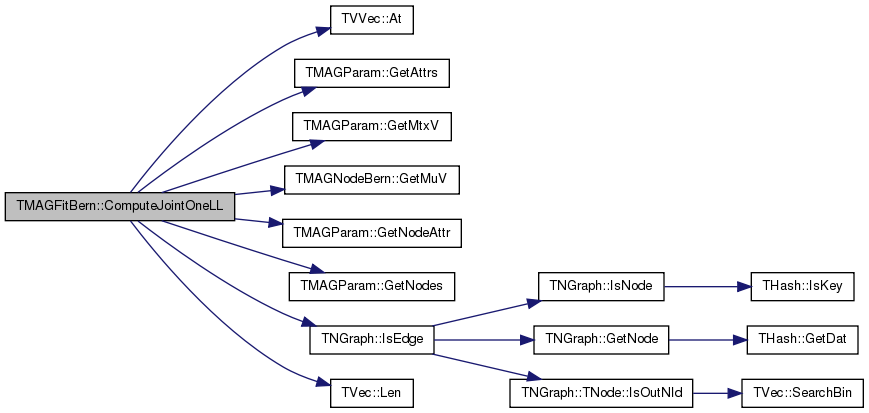

| const double TMAGFitBern::ComputeMI | ( | const TIntVV & | AttrV, |
| const int | AId1, | ||
| const int | AId2 | ||
| ) | [static] |
Definition at line 2091 of file mag.cpp.
References TVVec< TVal >::GetXDim(), TVec< TVal >::PutAll(), and TVVec< TVal >::PutAll().
Referenced by ComputeMI().
{
const int NNodes = AttrV.GetXDim();
double MI = 0.0;
double Cor = 0.0;
TFltVV Pxy(2,2);
TFltV Px(2), Py(2);
Pxy.PutAll(0.0);
Px.PutAll(0.0);
Py.PutAll(0.0);
for(int i = 0; i < NNodes; i++) {
int X = AttrV(i, AId1);
int Y = AttrV(i, AId2);
Pxy(X, Y) = Pxy(X, Y) + 1;
Px[X] = Px[X] + 1;
Py[Y] = Py[Y] + 1;
Cor += double(X * Y);
}
for(int x = 0; x < 2; x++) {
for(int y = 0; y < 2; y++) {
MI += Pxy(x, y) / double(NNodes) * (log(Pxy(x, y).Val) - log(Px[x].Val) - log(Py[y].Val) + log((double)NNodes));
}
}
return MI;
}
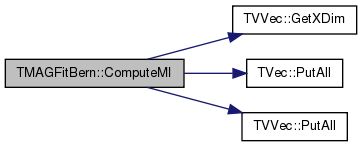

| const double TMAGFitBern::ComputeMI | ( | const TFltVV & | AttrV, |
| const int | AId1, | ||
| const int | AId2 | ||
| ) | [static] |
Definition at line 2120 of file mag.cpp.
References TVVec< TVal >::GetXDim(), TVec< TVal >::PutAll(), and TVVec< TVal >::PutAll().
{
const int NNodes = AttrV.GetXDim();
double MI = 0.0;
double Cor = 0.0;
TFltVV Pxy(2,2);
TFltV Px(2), Py(2);
Pxy.PutAll(0.0);
Px.PutAll(0.0);
Py.PutAll(0.0);
for(int i = 0; i < NNodes; i++) {
double X = AttrV(i, AId1);
double Y = AttrV(i, AId2);
Pxy(0, 0) = Pxy(0, 0) + X * Y;
Pxy(0, 1) = Pxy(0, 1) + X * (1 - Y);
Pxy(1, 0) = Pxy(1, 0) + (1 - X) * Y;
Pxy(1, 1) = (i+1) - Pxy(0, 0) - Pxy(0, 1) - Pxy(1, 0);
Px[0] = Px[0] + X;
Py[0] = Py[0] + Y;
Cor += double((1-X) * (1-Y));
}
Px[1] = NNodes - Px[0];
Py[1] = NNodes - Py[0];
for(int x = 0; x < 2; x++) {
for(int y = 0; y < 2; y++) {
MI += Pxy(x, y) / double(NNodes) * (log(Pxy(x, y)) - log(Px[x]) - log(Py[y]) + log(double(NNodes)));
}
}
return MI;
}
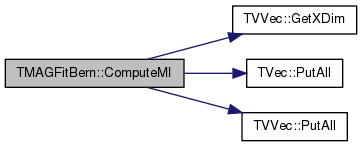
| const double TMAGFitBern::ComputeMI | ( | const TIntVV & | AttrV | ) | [static] |
Definition at line 2154 of file mag.cpp.
References ComputeMI(), and TVVec< TVal >::GetYDim().
{
// const int NNodes = AttrV.GetXDim();
const int NAttrs = AttrV.GetYDim();
double MI = 0.0;
for(int l = 0; l < NAttrs; l++) {
for(int k = l+1; k < NAttrs; k++) {
MI += ComputeMI(AttrV, l, k);
}
}
return MI;
}

| const double TMAGFitBern::ComputeMI | ( | const TFltVV & | AttrV | ) | [static] |
Definition at line 2168 of file mag.cpp.
References ComputeMI(), and TVVec< TVal >::GetYDim().
{
// const int NNodes = AttrV.GetXDim();
const int NAttrs = AttrV.GetYDim();
double MI = 0.0;
for(int l = 0; l < NAttrs; l++) {
for(int k = l+1; k < NAttrs; k++) {
MI += ComputeMI(AttrV, l, k);
}
}
return MI;
}

| void TMAGFitBern::CountAttr | ( | TFltV & | EstMuV | ) | const |
Definition at line 1814 of file mag.cpp.
References TVec< TVal >::Gen(), TVVec< TVal >::GetXDim(), TVVec< TVal >::GetYDim(), PhiVV, and TVec< TVal >::PutAll().
Referenced by SortAttrOrdering().
{
const int NNodes = PhiVV.GetXDim();
const int NAttrs = PhiVV.GetYDim();
EstMuV.Gen(NAttrs);
EstMuV.PutAll(0.0);
for(int l = 0; l < NAttrs; l++) {
for(int i = 0; i < NNodes; i++) {
EstMuV[l] = EstMuV[l] + PhiVV(i, l);
}
EstMuV[l] = EstMuV[l] / double(NNodes);
}
}


| void TMAGFitBern::DoEMAlg | ( | const int & | NStep, |
| const int & | NEstep, | ||
| const int & | NMstep, | ||
| const double & | LrnRate, | ||
| const double & | MaxGrad, | ||
| const double & | Lambda, | ||
| const double & | ReInit, | ||
| const int & | NReal = 0 |
||
| ) |
Definition at line 1630 of file mag.cpp.
References TVec< TVal >::Add(), TVVec< TVal >::At(), ComputeApxLL(), Debug, DoEStep(), DoMStep(), TVec< TVal >::Gen(), TMAGParam< TNodeAttr >::GetAttrs(), TMAGParam< TNodeAttr >::GetMtxV(), TMAGNodeBern::GetMuV(), TMAGParam< TNodeAttr >::GetNodeAttr(), TMAGParam< TNodeAttr >::GetNodes(), TRnd::GetUniDev(), KnownVV, LLHisV, MtxHisV, MuHisV, NormalizeAffMtxV(), NormConst, Param, PhiVV, TMAGParam< TNodeAttr >::SetMtxV(), and UnNormalizeAffMtxV().
{
const int NNodes = Param.GetNodes();
const int NAttrs = Param.GetAttrs();
TIntV IndexV;
double LL;
// double MuDist, MtxDist;
MuHisV.Gen(NStep + 1, 0);
MtxHisV.Gen(NStep + 1, 0);
LLHisV.Gen(NStep + 1, 0);
printf("--------------------------------------------\n");
printf("Before EM Iteration\n");
printf("--------------------------------------------\n");
TMAGAffMtxV InitMtxV;
TMAGNodeBern NodeAttr = Param.GetNodeAttr();
Param.GetMtxV(InitMtxV);
TFltV InitMuV = NodeAttr.GetMuV();
for(int i = 0; i < NNodes; i++) {
for(int l = 0; l < NAttrs; l++) {
if(! KnownVV(i, l)) {
PhiVV.At(i, l) = TMAGNodeBern::Rnd.GetUniDev();
}
}
}
if(Debug) {
double LL = ComputeApxLL();
MuHisV.Add(InitMuV);
MtxHisV.Add(InitMtxV);
LLHisV.Add(LL);
}
NormalizeAffMtxV(InitMtxV, true);
Param.SetMtxV(InitMtxV);
for(int n = 0; n < NStep; n++) {
printf("--------------------------------------------\n");
printf("EM Iteration : %d\n", (n+1));
printf("--------------------------------------------\n");
NodeAttr = Param.GetNodeAttr();
for(int i = 0; i < NNodes; i++) {
for(int l = 0; l < NAttrs; l++) {
if(!KnownVV(i, l) && TMAGNodeBern::Rnd.GetUniDev() < ReInit) {
PhiVV.At(i, l) = TMAGNodeBern::Rnd.GetUniDev();
}
}
}
DoEStep(InitMuV, NEstep, LL, Lambda);
Param.GetMtxV(InitMtxV);
// NormalizeAffMtxV(InitMtxV);
Param.SetMtxV(InitMtxV);
DoMStep(NMstep, LrnRate, MaxGrad, Lambda, NReal);
printf("\n");
if(Debug) {
double LL = ComputeApxLL();
MuHisV.Add(InitMuV);
MtxHisV.Add(InitMtxV);
LLHisV.Add(LL);
printf(" ApxLL = %.2f (Const = %f)\n", LL, double(NormConst));
}
}
Param.GetMtxV(InitMtxV);
UnNormalizeAffMtxV(InitMtxV, true);
Param.SetMtxV(InitMtxV);
}
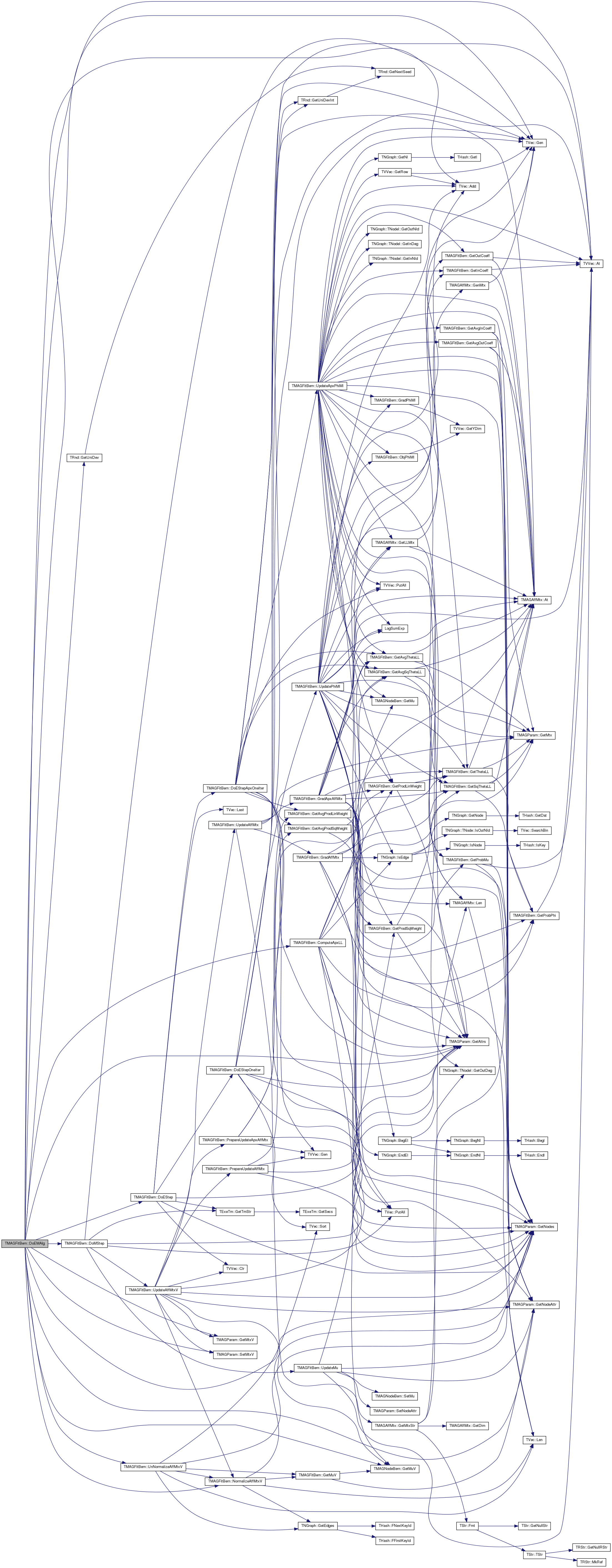
| double TMAGFitBern::DoEStep | ( | const TFltV & | TrueMuV, |
| const int & | NIter, | ||
| double & | LL, | ||
| const double & | Lambda | ||
| ) |
Definition at line 1272 of file mag.cpp.
References TVVec< TVal >::Clr(), DoEStepApxOneIter(), DoEStepOneIter(), ESpeedUp, TMAGParam< TNodeAttr >::GetAttrs(), TMAGParam< TNodeAttr >::GetNodes(), TExeTm::GetTmStr(), TVec< TVal >::Last(), and Param.
Referenced by DoEMAlg().
{
const int NNodes = Param.GetNodes();
const int NAttrs = Param.GetAttrs();
TFltVV NewPhiVV(NNodes, NAttrs);
// double MI;
TFltV Delta(NIter);
for(int i = 0; i < NIter; i++) {
TExeTm IterTm;
printf("EStep iteration : %d\n", (i+1));
if(ESpeedUp) {
Delta[i] = DoEStepApxOneIter(TrueMuV, NewPhiVV, Lambda);
} else {
Delta[i] = DoEStepOneIter(TrueMuV, NewPhiVV, Lambda);
}
// PhiVV = NewPhiVV;
printf(" (Time = %s)\n", IterTm.GetTmStr());
}
printf("\n");
NewPhiVV.Clr();
return Delta.Last();
}
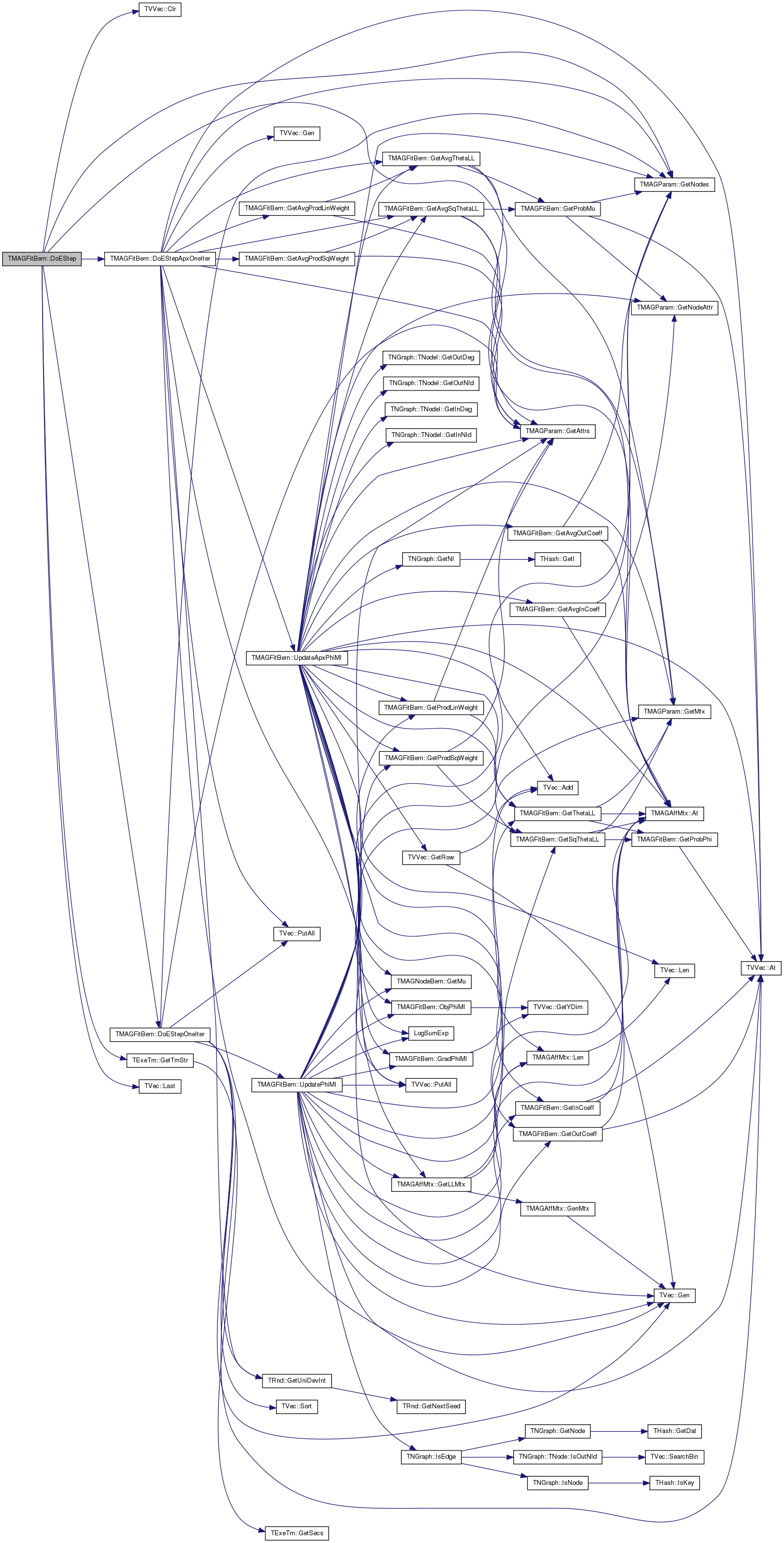

| double TMAGFitBern::DoEStepApxOneIter | ( | const TFltV & | TrueMuV, |
| TFltVV & | NewPhi, | ||
| const double & | Lambda | ||
| ) |
Definition at line 1134 of file mag.cpp.
References TVVec< TVal >::At(), AvgPhiPairVV, AvgPhiV, TVec< TVal >::Gen(), TVVec< TVal >::Gen(), TMAGParam< TNodeAttr >::GetAttrs(), GetAvgProdLinWeight(), GetAvgProdSqWeight(), GetAvgSqThetaLL(), GetAvgThetaLL(), TMAGParam< TNodeAttr >::GetNodes(), TRnd::GetUniDevInt(), KnownVV, Param, PhiVV, TVec< TVal >::PutAll(), TVVec< TVal >::PutAll(), and UpdateApxPhiMI().
Referenced by DoEStep().
{
const int NNodes = Param.GetNodes();
const int NAttrs = Param.GetAttrs();
double MaxDelta = 0, L1 = 0;
double Val;
TFltIntIntTrV NewVal;
int RndCount = 0;
// double OldMI = 0.0, NewMI = 0.0;
TFltV MuV(NAttrs); MuV.PutAll(0.0);
TFltVV ProdVV(NNodes, 4); ProdVV.PutAll(0.0);
TIntV NIndV(NNodes), AIndV(NAttrs);
// Update Phi
/*
for(int i = 0; i < NNodes; i++) { NIndV[i] = i; }
for(int l = 0; l < NAttrs; l++) { AIndV[l] = l; }
if(Randomized) {
NIndV.Shuffle(TMAGNodeBern::Rnd);
AIndV.Shuffle(TMAGNodeBern::Rnd);
}
*/
AvgPhiV.Gen(NAttrs); AvgPhiV.PutAll(0.0);
AvgPhiPairVV.Gen(NAttrs, 4*NAttrs); AvgPhiPairVV.PutAll(0.0);
for(int i = 0; i < NNodes; i++) {
for(int l = 0; l < NAttrs; l++) {
for(int p = l+1; p < NAttrs; p++) {
int index = 4 * p;
AvgPhiPairVV(l, index) += PhiVV(i, l) * PhiVV(i, p);
AvgPhiPairVV(l, index+1) += PhiVV(i, l) * (1.0-PhiVV(i, p));
AvgPhiPairVV(l, index+2) += (1.0-PhiVV(i, l)) * PhiVV(i, p);
AvgPhiPairVV(l, index+3) += (1.0-PhiVV(i, l)) * (1.0-PhiVV(i, p));
}
AvgPhiV[l] += PhiVV(i, l);
}
}
for(int i = 0; i < NNodes; i++) {
ProdVV(i, 0) = GetAvgProdLinWeight(i, i, true, false);
ProdVV(i, 1) = GetAvgProdLinWeight(i, i, false, true);
ProdVV(i, 2) = GetAvgProdSqWeight(i, i, true, false);
ProdVV(i, 3) = GetAvgProdSqWeight(i, i, false, true);
}
const int Iter = 3;
int NId;
NewVal.Gen(NAttrs * Iter);
for(int i = 0; i < NNodes * Iter; i++) {
for(int l = 0; l < NAttrs; l++) {
const int AId = TMAGNodeBern::Rnd.GetUniDevInt(NAttrs);
double Delta = 0.0;
if(KnownVV(NId, AId)) {
Val = PhiVV.At(NId, AId);
} else {
Delta = UpdateApxPhiMI(Lambda, NId, AId, Val, ProdVV);
}
// PhiVV.At(NId, AId) = Val;
NewVal[l] = TFltIntIntTr(Val, NId, AId);
// MuV[AId] = MuV[AId] + Val;
if(fabs(Delta) > MaxDelta) {
MaxDelta = fabs(Delta);
}
if(Val > 0.3 && Val < 0.7) { RndCount++; }
}
for(int l = 0; l < NAttrs; l++) {
const int NId = NewVal[l].Val2;
const int AId = NewVal[l].Val3;
ProdVV(NId, 0) -= GetAvgThetaLL(NId, NId, AId, true, false);
ProdVV(NId, 1) -= GetAvgThetaLL(NId, NId, AId, false, true);
ProdVV(NId, 2) -= GetAvgSqThetaLL(NId, NId, AId, true, false);
ProdVV(NId, 3) -= GetAvgSqThetaLL(NId, NId, AId, false, true);
for(int p = 0; p < NAttrs; p++) {
if(p > AId) {
int index = 4 * p;
AvgPhiPairVV(AId, index) -= PhiVV(NId, AId) * PhiVV(NId, p);
AvgPhiPairVV(AId, index+1) -= PhiVV(NId, AId) * (1.0-PhiVV(NId, p));
AvgPhiPairVV(AId, index+2) -= (1.0-PhiVV(NId, AId)) * PhiVV(NId, p);
AvgPhiPairVV(AId, index+3) -= (1.0-PhiVV(NId, AId)) * (1.0-PhiVV(NId, p));
} else if (p < AId) {
int index = 4 * AId;
AvgPhiPairVV(p, index) -= PhiVV(NId, p) * PhiVV(NId, AId);
AvgPhiPairVV(p, index+1) -= PhiVV(NId, p) * (1.0-PhiVV(NId, AId));
AvgPhiPairVV(p, index+2) -= (1.0-PhiVV(NId, p)) * PhiVV(NId, AId);
AvgPhiPairVV(p, index+3) -= (1.0-PhiVV(NId, p)) * (1.0-PhiVV(NId, AId));
}
}
AvgPhiV[AId] -= PhiVV(NId, AId);
PhiVV.At(NId, AId) = NewVal[l].Val1;
ProdVV(NId, 0) += GetAvgThetaLL(NId, NId, AId, true, false);
ProdVV(NId, 1) += GetAvgThetaLL(NId, NId, AId, false, true);
ProdVV(NId, 2) += GetAvgSqThetaLL(NId, NId, AId, true, false);
ProdVV(NId, 3) += GetAvgSqThetaLL(NId, NId, AId, false, true);
for(int p = 0; p < NAttrs; p++) {
if(p > AId) {
int index = 4 * p;
AvgPhiPairVV(AId, index) += PhiVV(NId, AId) * PhiVV(NId, p);
AvgPhiPairVV(AId, index+1) += PhiVV(NId, AId) * (1.0-PhiVV(NId, p));
AvgPhiPairVV(AId, index+2) += (1.0-PhiVV(NId, AId)) * PhiVV(NId, p);
AvgPhiPairVV(AId, index+3) += (1.0-PhiVV(NId, AId)) * (1.0-PhiVV(NId, p));
} else if (p < AId) {
int index = 4 * AId;
AvgPhiPairVV(p, index) += PhiVV(NId, p) * PhiVV(NId, AId);
AvgPhiPairVV(p, index+1) += PhiVV(NId, p) * (1.0-PhiVV(NId, AId));
AvgPhiPairVV(p, index+2) += (1.0-PhiVV(NId, p)) * PhiVV(NId, AId);
AvgPhiPairVV(p, index+3) += (1.0-PhiVV(NId, p)) * (1.0-PhiVV(NId, AId));
}
}
AvgPhiV[AId] += PhiVV(NId, AId);
}
}
for(int l = 0; l < NAttrs; l++) {
MuV[l] = AvgPhiV[l] / double(NNodes);
}
TFltV SortMuV = MuV;
double Avg = 0.0;
// SortMuV.Sort(false);
for(int l = 0; l < NAttrs; l++) {
printf(" F[%d] = %.3f", l, double(MuV[l]));
Avg += SortMuV[l];
// L1 += fabs(TrueMuV[l] - SortMuV[l]);
}
printf("\n");
printf(" Rnd = %d(%.3f)", RndCount, double(RndCount) / double(NNodes * NAttrs));
printf(" Avg = %.3f\n", Avg / double(NAttrs));
// printf(" Linf = %f\n", MaxDelta);
// L1 /= double(NAttrs);
return L1;
}
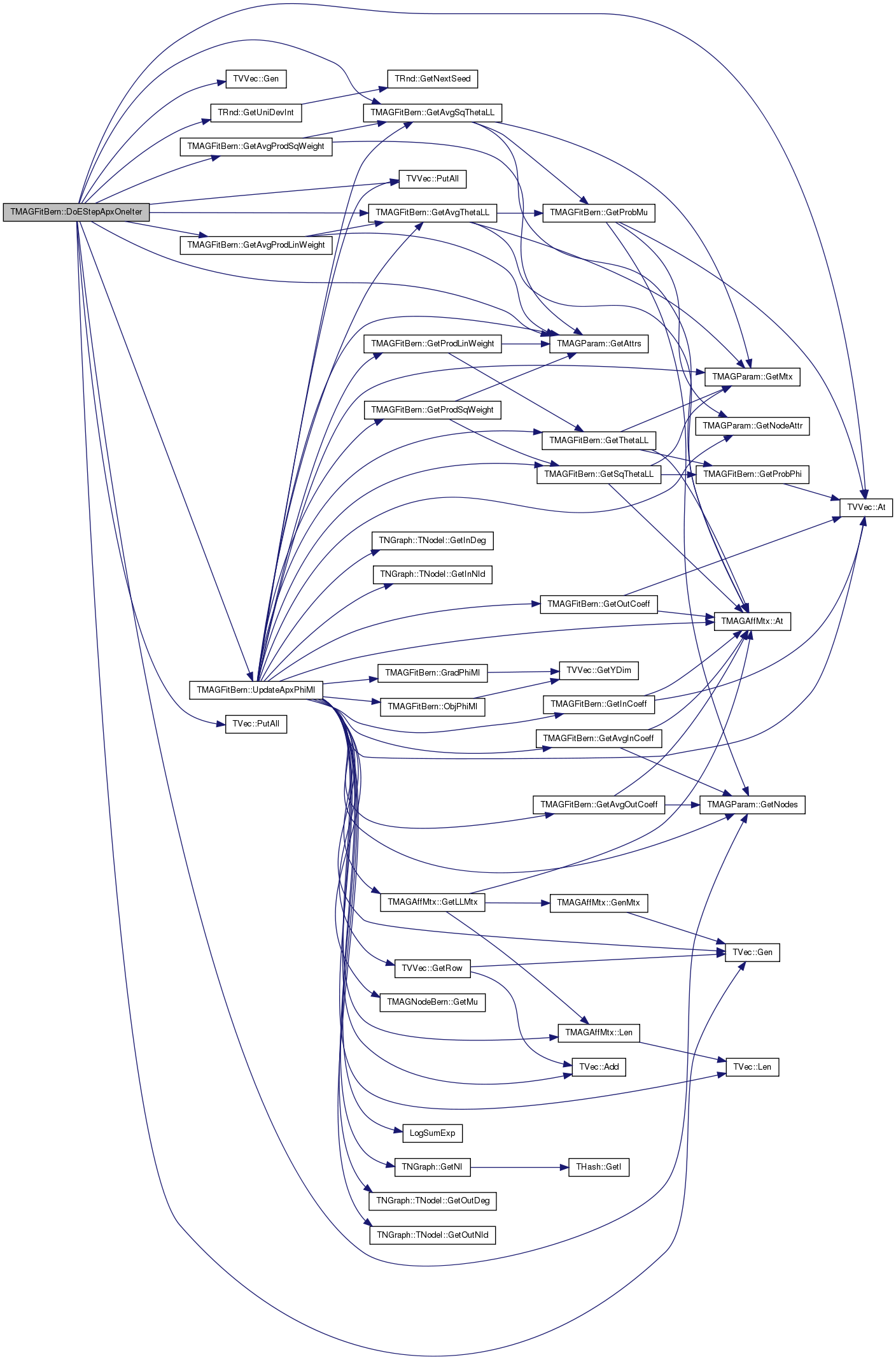

| double TMAGFitBern::DoEStepOneIter | ( | const TFltV & | TrueMuV, |
| TFltVV & | NewPhi, | ||
| const double & | Lambda | ||
| ) |
Definition at line 1056 of file mag.cpp.
References TVVec< TVal >::At(), TVec< TVal >::Gen(), TMAGParam< TNodeAttr >::GetAttrs(), TMAGParam< TNodeAttr >::GetNodes(), TRnd::GetUniDevInt(), KnownVV, Param, PhiVV, TVec< TVal >::PutAll(), TVec< TVal >::Sort(), and UpdatePhiMI().
Referenced by DoEStep().
{
const int NNodes = Param.GetNodes();
const int NAttrs = Param.GetAttrs();
double MaxDelta = 0, L1 = 0;
double Val;
TFltIntIntTrV NewVal;
int RndCount = 0;
// double OldMI = 0.0, NewMI = 0.0;
TFltV MuV(NAttrs); MuV.PutAll(0.0);
TIntV NIndV(NNodes), AIndV(NAttrs);
// Update Phi
/*
for(int i = 0; i < NNodes; i++) { NIndV[i] = i; }
for(int l = 0; l < NAttrs; l++) { AIndV[l] = l; }
if(Randomized) {
NIndV.Shuffle(TMAGNodeBern::Rnd);
AIndV.Shuffle(TMAGNodeBern::Rnd);
}
*/
NewVal.Gen(NAttrs * 2);
for(int i = 0; i < NNodes; i++) {
// const int NId = NIndV[i]%NNodes;
for(int l = 0; l < NAttrs * 2; l++) {
const int NId = TMAGNodeBern::Rnd.GetUniDevInt(NNodes);
const int AId = TMAGNodeBern::Rnd.GetUniDevInt(NAttrs);
// const int AId = AIndV[l]%NAttrs;
// double Delta = UpdatePhi(NId, AId, Val);
double Delta = 0.0;
if(KnownVV(NId, AId)) {
Val = PhiVV.At(NId, AId);
} else {
Delta = UpdatePhiMI(Lambda, NId, AId, Val);
}
// PhiVV.At(NId, AId) = Val;
NewVal[l] = TFltIntIntTr(Val, NId, AId);
// MuV[AId] = MuV[AId] + Val;
if(fabs(Delta) > MaxDelta) {
MaxDelta = fabs(Delta);
}
if(Val > 0.3 && Val < 0.7) { RndCount++; }
}
for(int l = 0; l < NAttrs * 2; l++) {
const int NId = NewVal[l].Val2;
const int AId = NewVal[l].Val3;
PhiVV.At(NId, AId) = NewVal[l].Val1;
}
}
for(int i = 0; i < NNodes; i++) {
for(int l = 0; l < NAttrs; l++) {
MuV[l] = MuV[l] + PhiVV.At(i, l);
}
}
for(int l = 0; l < NAttrs; l++) {
MuV[l] = MuV[l] / double(NNodes);
}
TFltV SortMuV = MuV;
double Avg = 0.0;
SortMuV.Sort(false);
for(int l = 0; l < NAttrs; l++) {
printf(" F[%d] = %.3f", l, double(MuV[l]));
Avg += SortMuV[l];
L1 += fabs(TrueMuV[l] - SortMuV[l]);
}
printf("\n");
printf(" Rnd = %d(%.3f)", RndCount, double(RndCount) / double(NNodes * NAttrs));
printf(" Avg = %.3f\n", Avg / double(NAttrs));
L1 /= double(NAttrs);
return L1;
}
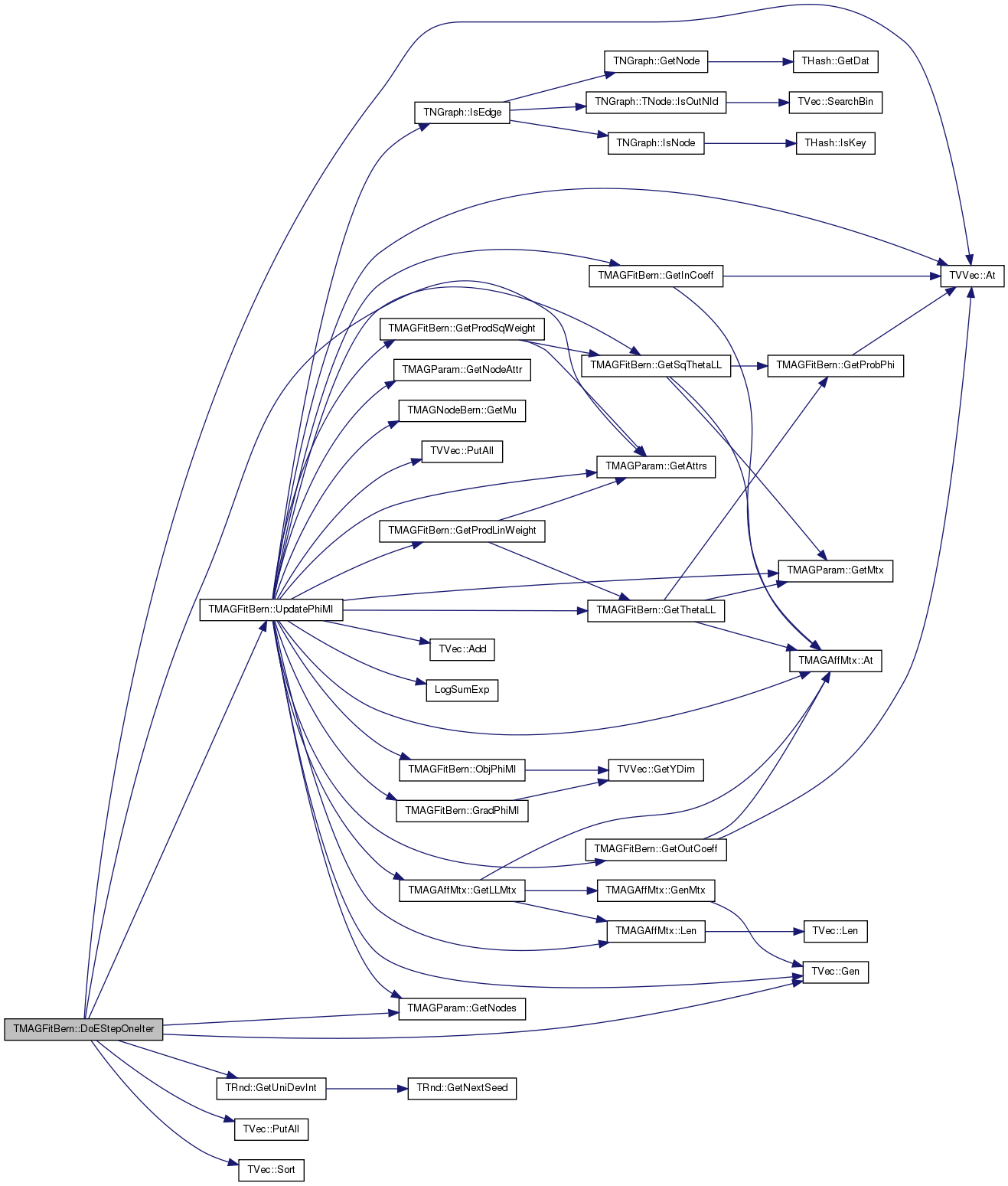

| void TMAGFitBern::DoMStep | ( | const int & | GradIter, |
| const double & | LrnRate, | ||
| const double & | MaxGrad, | ||
| const double & | Lambda, | ||
| const int & | NReal = 0 |
||
| ) |
Definition at line 1608 of file mag.cpp.
References AvgPhiV, TVec< TVal >::Gen(), TMAGParam< TNodeAttr >::GetAttrs(), TExeTm::GetTmStr(), Param, TVec< TVal >::PutAll(), UpdateAffMtxV(), and UpdateMu().
Referenced by DoEMAlg().
{
// const int NNodes = Param.GetNodes();
const int NAttrs = Param.GetAttrs();
double MuDelta = 0.0, AffMtxDelta = 0.0;
TExeTm ExeTm;
printf("\n");
AvgPhiV.Gen(NAttrs); AvgPhiV.PutAll(0.0);
for(int l = 0; l < NAttrs; l++) {
// printf(" [Attr = %d]\n", l);
MuDelta += UpdateMu(l);
}
printf("\n");
printf(" == Update Theta\n");
AffMtxDelta += UpdateAffMtxV(GradIter, LrnRate, MaxGrad, Lambda, NReal);
printf("\n");
printf("Elpased time = %s\n", ExeTm.GetTmStr());
printf("\n");
}
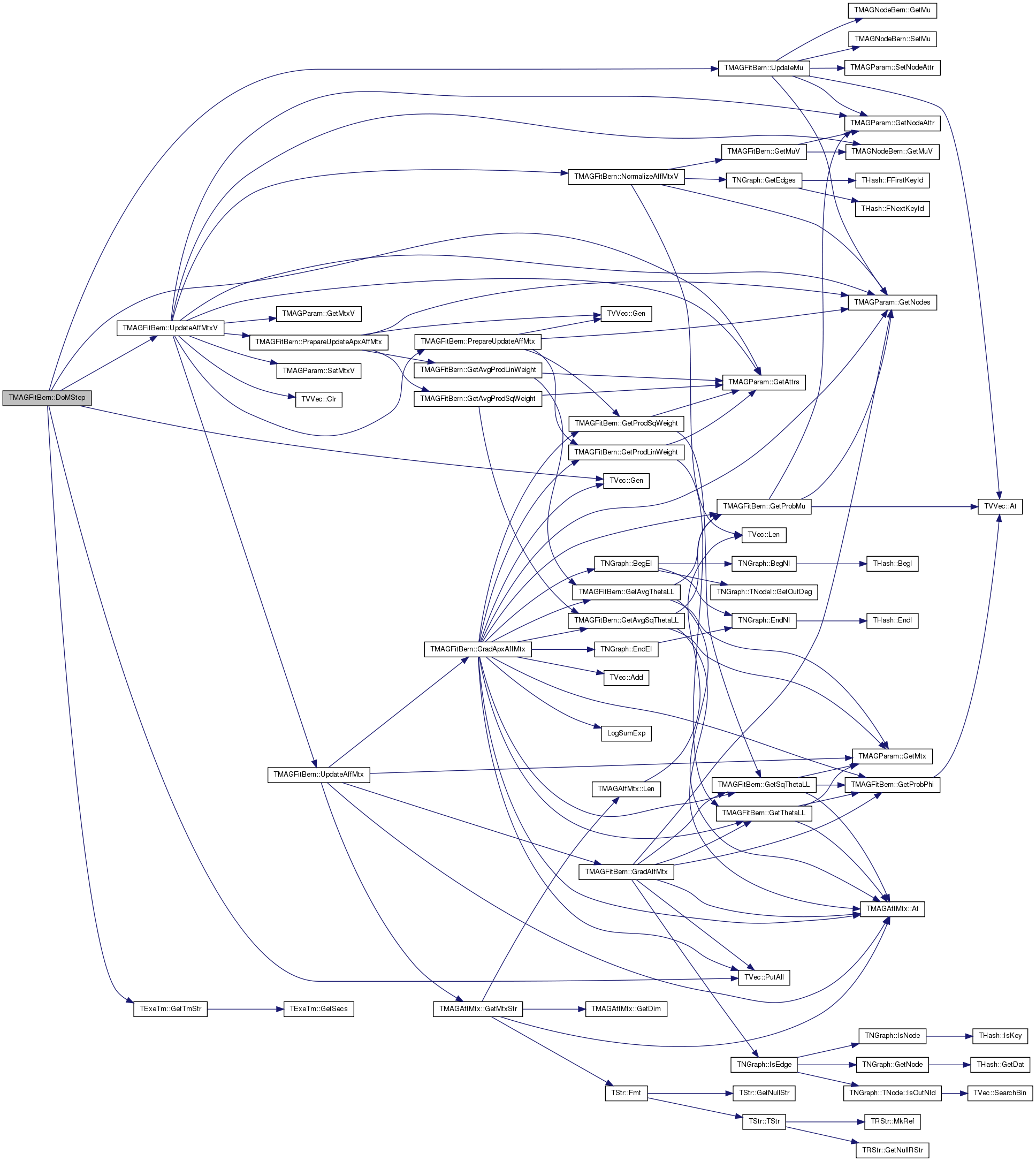

| const int TMAGFitBern::GetAttrs | ( | ) | const [inline] |
| const double TMAGFitBern::GetAvgInCoeff | ( | const int & | i, |
| const int & | AId, | ||
| const int & | A, | ||
| const TMAGAffMtx & | Theta | ||
| ) | const |
Definition at line 558 of file mag.cpp.
References TMAGAffMtx::At(), AvgPhiV, TMAGParam< TNodeAttr >::GetNodes(), and Param.
Referenced by UpdateApxPhiMI().
{
const int NNodes = Param.GetNodes();
const double Mu_l = AvgPhiV[AId] / double(NNodes);
return (Mu_l * Theta.At(0, A) + (1.0 - Mu_l) * Theta.At(1, A));
}


| const double TMAGFitBern::GetAvgOutCoeff | ( | const int & | i, |
| const int & | AId, | ||
| const int & | A, | ||
| const TMAGAffMtx & | Theta | ||
| ) | const |
Definition at line 564 of file mag.cpp.
References TMAGAffMtx::At(), AvgPhiV, TMAGParam< TNodeAttr >::GetNodes(), and Param.
Referenced by UpdateApxPhiMI().
{
const int NNodes = Param.GetNodes();
const double Mu_l = AvgPhiV[AId] / double(NNodes);
return (Mu_l * Theta.At(A, 0) + (1.0 - Mu_l) * Theta.At(A, 1));
}


| const double TMAGFitBern::GetAvgProdLinWeight | ( | const int & | NId1, |
| const int & | NId2, | ||
| const bool | Left = false, |
||
| const bool | Right = false |
||
| ) | const |
Definition at line 642 of file mag.cpp.
References TMAGParam< TNodeAttr >::GetAttrs(), GetAvgThetaLL(), NormConst, and Param.
Referenced by DoEStepApxOneIter(), and PrepareUpdateApxAffMtx().
{
const int NAttrs = Param.GetAttrs();
double LL = 0.0;
for(int l = 0; l < NAttrs; l++) {
LL += GetAvgThetaLL(NId1, NId2, l, Left, Right);
}
// return LL;
return LL + log(NormConst);
}


| const double TMAGFitBern::GetAvgProdSqWeight | ( | const int & | NId1, |
| const int & | NId2, | ||
| const bool | Left = false, |
||
| const bool | Right = false |
||
| ) | const |
Definition at line 664 of file mag.cpp.
References TMAGParam< TNodeAttr >::GetAttrs(), GetAvgSqThetaLL(), NormConst, and Param.
Referenced by DoEStepApxOneIter(), and PrepareUpdateApxAffMtx().
{
const int NAttrs = Param.GetAttrs();
double LL = 0.0;
for(int l = 0; l < NAttrs; l++) {
LL += GetAvgSqThetaLL(NId1, NId2, l, Left, Right);
}
// return LL;
return LL + 2 * log(NormConst);
}


| const double TMAGFitBern::GetAvgSqThetaLL | ( | const int & | NId1, |
| const int & | NId2, | ||
| const int & | AId, | ||
| const bool | Left = false, |
||
| const bool | Right = false |
||
| ) | const |
Definition at line 620 of file mag.cpp.
References TMAGAffMtx::At(), TMAGParam< TNodeAttr >::GetMtx(), GetProbMu(), and Param.
Referenced by DoEStepApxOneIter(), GetAvgProdSqWeight(), GradApxAffMtx(), and UpdateApxPhiMI().
{
double LL = 0.0;
const TMAGAffMtx& Mtx = Param.GetMtx(AId);
for(int A1 = 0; A1 < 2; A1++) {
for(int A2 = 0; A2 < 2; A2++) {
LL += GetProbMu(NId1, NId2, AId, A1, A2, Left, Right) * Mtx.At(A1, A2) * Mtx.At(A1, A2);
}
}
return log(LL);
}


| const double TMAGFitBern::GetAvgThetaLL | ( | const int & | NId1, |
| const int & | NId2, | ||
| const int & | AId, | ||
| const bool | Left = false, |
||
| const bool | Right = false |
||
| ) | const |
Definition at line 598 of file mag.cpp.
References TMAGAffMtx::At(), TMAGParam< TNodeAttr >::GetMtx(), GetProbMu(), and Param.
Referenced by DoEStepApxOneIter(), GetAvgProdLinWeight(), GradApxAffMtx(), and UpdateApxPhiMI().
{
double LL = 0.0;
const TMAGAffMtx& Mtx = Param.GetMtx(AId);
for(int A1 = 0; A1 < 2; A1++) {
for(int A2 = 0; A2 < 2; A2++) {
LL += GetProbMu(NId1, NId2, AId, A1, A2, Left, Right) * Mtx.At(A1, A2);
}
}
return log(LL);
}


| const double TMAGFitBern::GetEstNoEdgeLL | ( | const int & | NId, |
| const int & | AId | ||
| ) | const |
Definition at line 746 of file mag.cpp.
References TMAGParam< TNodeAttr >::GetNodeAttr(), and Param.
{
// const int NNodes = Param.GetNodes();
// const int NAttrs = Param.GetAttrs();
TMAGNodeBern DistParam = Param.GetNodeAttr();
double LL = 0.0;
return LL;
}

| PNGraph TMAGFitBern::GetGraph | ( | ) | [inline] |
| const double TMAGFitBern::GetInCoeff | ( | const int & | i, |
| const int & | j, | ||
| const int & | l, | ||
| const int & | A, | ||
| const TMAGAffMtx & | Theta | ||
| ) | const |
Definition at line 550 of file mag.cpp.
References TMAGAffMtx::At(), TVVec< TVal >::At(), and PhiVV.
Referenced by UpdateApxPhiMI(), UpdatePhi(), and UpdatePhiMI().


| void TMAGFitBern::GetMtxV | ( | TMAGAffMtxV & | MtxV | ) | const [inline] |
| const TFltV& TMAGFitBern::GetMuV | ( | ) | const [inline] |
Definition at line 379 of file mag.h.
References TMAGNodeBern::GetMuV(), TMAGParam< TNodeAttr >::GetNodeAttr(), and Param.
Referenced by NormalizeAffMtxV(), SaveTxt(), and UnNormalizeAffMtxV().
{ const TMAGNodeBern& Dist = Param.GetNodeAttr(); return Dist.GetMuV(); }


| const TMAGNodeBern& TMAGFitBern::GetNodeAttr | ( | ) | const [inline] |
Definition at line 378 of file mag.h.
References TMAGParam< TNodeAttr >::GetNodeAttr(), and Param.
{ return Param.GetNodeAttr(); }

| const int TMAGFitBern::GetNodes | ( | ) | const [inline] |
| const double TMAGFitBern::GetOutCoeff | ( | const int & | i, |
| const int & | j, | ||
| const int & | l, | ||
| const int & | A, | ||
| const TMAGAffMtx & | Theta | ||
| ) | const |
Definition at line 554 of file mag.cpp.
References TMAGAffMtx::At(), TVVec< TVal >::At(), and PhiVV.
Referenced by UpdateApxPhiMI(), UpdatePhi(), and UpdatePhiMI().


| const TMAGParam<TMAGNodeBern>& TMAGFitBern::GetParams | ( | ) | const [inline] |
| const TFltVV& TMAGFitBern::GetPhiVV | ( | ) | const [inline] |
| const double TMAGFitBern::GetProbMu | ( | const int & | NId1, |
| const int & | NId2, | ||
| const int & | AId, | ||
| const int & | Attr1, | ||
| const int & | Attr2, | ||
| const bool | Left = false, |
||
| const bool | Right = false |
||
| ) | const |
Definition at line 576 of file mag.cpp.
References TVVec< TVal >::At(), AvgPhiV, TMAGParam< TNodeAttr >::GetNodeAttr(), TMAGParam< TNodeAttr >::GetNodes(), Param, and PhiVV.
Referenced by GetAvgSqThetaLL(), GetAvgThetaLL(), and GradApxAffMtx().
{
TMAGNodeBern DistParam = Param.GetNodeAttr();
// double Mu = DistParam.GetMu(AId);
double Mu = AvgPhiV[AId] / double(Param.GetNodes());
double Prob1 = (Left) ? double(PhiVV.At(NId1, AId)) : double(Mu);
double Prob2 = (Right)? double(PhiVV.At(NId2, AId)) : double(Mu);
Prob1 = (Attr1 == 0) ? Prob1 : 1.0 - Prob1;
Prob2 = (Attr2 == 0) ? Prob2 : 1.0 - Prob2;
return (Prob1 * Prob2);
}


| const double TMAGFitBern::GetProbPhi | ( | const int & | NId1, |
| const int & | NId2, | ||
| const int & | AId, | ||
| const int & | Attr1, | ||
| const int & | Attr2 | ||
| ) | const |
Definition at line 570 of file mag.cpp.
References TVVec< TVal >::At(), and PhiVV.
Referenced by ComputeApxAdjLL(), ComputeApxLL(), GetSqThetaLL(), GetThetaLL(), GradAffMtx(), and GradApxAffMtx().
{
double Prob1 = (Attr1 == 0) ? double(PhiVV.At(NId1, AId)) : (1.0 - PhiVV.At(NId1, AId));
double Prob2 = (Attr2 == 0) ? double(PhiVV.At(NId2, AId)) : (1.0 - PhiVV.At(NId2, AId));
return (Prob1 * Prob2);
}


| const double TMAGFitBern::GetProdLinWeight | ( | const int & | NId1, |
| const int & | NId2 | ||
| ) | const |
Definition at line 631 of file mag.cpp.
References TMAGParam< TNodeAttr >::GetAttrs(), GetThetaLL(), NormConst, and Param.
Referenced by ComputeApxAdjLL(), ComputeApxLL(), GradApxAffMtx(), PrepareUpdateAffMtx(), UpdateApxPhiMI(), UpdatePhi(), and UpdatePhiMI().
{
const int NAttrs = Param.GetAttrs();
double LL = 0.0;
for(int l = 0; l < NAttrs; l++) {
LL += GetThetaLL(NId1, NId2, l);
}
// return LL;
return LL + log(NormConst);
}


| const double TMAGFitBern::GetProdSqWeight | ( | const int & | NId1, |
| const int & | NId2 | ||
| ) | const |
Definition at line 653 of file mag.cpp.
References TMAGParam< TNodeAttr >::GetAttrs(), GetSqThetaLL(), NormConst, and Param.
Referenced by GradApxAffMtx(), PrepareUpdateAffMtx(), UpdateApxPhiMI(), UpdatePhi(), and UpdatePhiMI().
{
const int NAttrs = Param.GetAttrs();
double LL = 0.0;
for(int l = 0; l < NAttrs; l++) {
LL += GetSqThetaLL(NId1, NId2, l);
}
// return LL;
return LL + 2 * log(NormConst);
}


| const double TMAGFitBern::GetSqThetaLL | ( | const int & | NId1, |
| const int & | NId2, | ||
| const int & | AId | ||
| ) | const |
Definition at line 609 of file mag.cpp.
References TMAGAffMtx::At(), TMAGParam< TNodeAttr >::GetMtx(), GetProbPhi(), and Param.
Referenced by GetProdSqWeight(), GradAffMtx(), GradApxAffMtx(), UpdateApxPhiMI(), UpdatePhi(), and UpdatePhiMI().
{
double LL = 0.0;
const TMAGAffMtx& Mtx = Param.GetMtx(AId);
for(int A1 = 0; A1 < 2; A1++) {
for(int A2 = 0; A2 < 2; A2++) {
LL += GetProbPhi(NId1, NId2, AId, A1, A2) * Mtx.At(A1, A2) * Mtx.At(A1, A2);
}
}
return log(LL);
}


| const double TMAGFitBern::GetThetaLL | ( | const int & | NId1, |
| const int & | NId2, | ||
| const int & | AId | ||
| ) | const |
Definition at line 587 of file mag.cpp.
References TMAGAffMtx::At(), TMAGParam< TNodeAttr >::GetMtx(), GetProbPhi(), and Param.
Referenced by GetProdLinWeight(), GradAffMtx(), GradApxAffMtx(), UpdateApxPhiMI(), UpdatePhi(), and UpdatePhiMI().
{
double LL = 0.0;
const TMAGAffMtx& Mtx = Param.GetMtx(AId);
for(int A1 = 0; A1 < 2; A1++) {
for(int A2 = 0; A2 < 2; A2++) {
LL += GetProbPhi(NId1, NId2, AId, A1, A2) * Mtx.At(A1, A2);
}
}
return log(LL);
}


| const void TMAGFitBern::GradAffMtx | ( | const int & | AId, |
| const TFltVV & | ProdVV, | ||
| const TFltVV & | SqVV, | ||
| const TMAGAffMtx & | CurMtx, | ||
| TFltV & | GradV | ||
| ) |
Definition at line 1320 of file mag.cpp.
References TMAGAffMtx::At(), TMAGParam< TNodeAttr >::GetNodes(), GetProbPhi(), GetSqThetaLL(), GetThetaLL(), Graph, TNGraph::IsEdge(), Param, and TVec< TVal >::PutAll().
Referenced by UpdateAffMtx().
{
const int NNodes = Param.GetNodes();
// const int NAttrs = Param.GetAttrs();
GradV.PutAll(0.0);
for(int i = 0; i < NNodes; i++) {
for(int j = 0; j < NNodes; j++) {
double Prod = ProdVV(i, j) - GetThetaLL(i, j, AId);
double Sq = SqVV(i, j) - GetSqThetaLL(i, j, AId);
for(int p = 0; p < 4; p++) {
int Ai = p / 2;
int Aj = p % 2;
double Prob = GetProbPhi(i, j, AId, Ai, Aj);
if(Graph->IsEdge(i, j)) {
GradV[p] += Prob / CurMtx.At(p);
} else {
GradV[p] -= Prob * exp(Prod);
GradV[p] -= Prob * exp(Sq) * CurMtx.At(p);
}
}
}
}
}
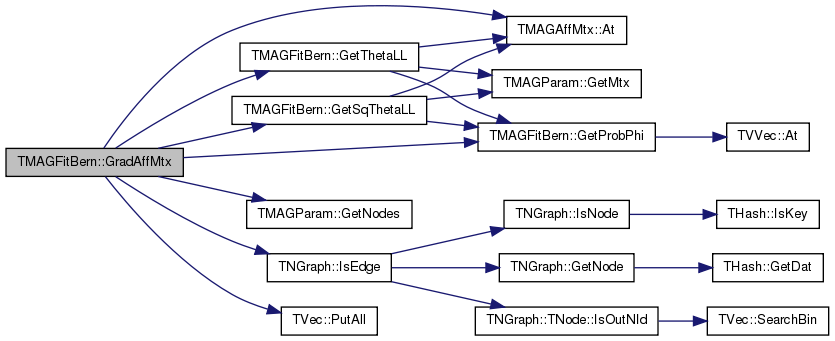

| const void TMAGFitBern::GradApxAffMtx | ( | const int & | AId, |
| const TFltVV & | ProdVV, | ||
| const TFltVV & | SqVV, | ||
| const TMAGAffMtx & | CurMtx, | ||
| TFltV & | GradV | ||
| ) |
Definition at line 1346 of file mag.cpp.
References TVec< TVal >::Add(), TMAGAffMtx::At(), TNGraph::BegEI(), TNGraph::EndEI(), TVec< TVal >::Gen(), GetAvgSqThetaLL(), GetAvgThetaLL(), TMAGParam< TNodeAttr >::GetNodes(), GetProbMu(), GetProbPhi(), GetProdLinWeight(), GetProdSqWeight(), GetSqThetaLL(), GetThetaLL(), Graph, LogSumExp(), Param, and TVec< TVal >::PutAll().
Referenced by UpdateAffMtx().
{
const int NNodes = Param.GetNodes();
// const int NAttrs = Param.GetAttrs();
// const int NSq = NNodes * (NNodes - 1);
GradV.PutAll(0.0);
TFltV LogSumV;
for(int p = 0; p < 4; p++) {
int Ai = p / 2;
int Aj = p % 2;
LogSumV.Gen(NNodes * 4, 0);
for(int i = 0; i < NNodes; i++) {
const double LProd = ProdVV(i, 0) - GetAvgThetaLL(i, i, AId, true, false);
const double LSq = SqVV(i, 0) - GetAvgSqThetaLL(i, i, AId, true, false);
const double RProd = ProdVV(i, 1) - GetAvgThetaLL(i, i, AId, false, true);
const double RSq = SqVV(i, 1) - GetAvgSqThetaLL(i, i, AId, false, true);
LogSumV.Add(LProd + log(GetProbMu(i, i, AId, Ai, Aj, true, false)));
LogSumV.Add(LSq + log(GetProbMu(i, i, AId, Ai, Aj, true, false)) + log(CurMtx.At(p)));
LogSumV.Add(RProd + log(GetProbMu(i, i, AId, Ai, Aj, false, true)));
LogSumV.Add(RSq + log(GetProbMu(i, i, AId, Ai, Aj, false, true)) + log(CurMtx.At(p)));
}
double LogSum = LogSumExp(LogSumV);
GradV[p] -= (NNodes - 1) * 0.5 * exp(LogSum);
}
for(TNGraph::TEdgeI EI = Graph->BegEI(); EI < Graph->EndEI(); EI++) {
const int NId1 = EI.GetSrcNId();
const int NId2 = EI.GetDstNId();
const double ProdOne = GetProdLinWeight(NId1, NId2) - GetThetaLL(NId1, NId2, AId);
const double SqOne = GetProdSqWeight(NId1, NId2) - GetSqThetaLL(NId1, NId2, AId);
for(int p = 0; p < 4; p++) {
int Ai = p / 2;
int Aj = p % 2;
double Prob = GetProbPhi(NId1, NId2, AId, Ai, Aj);
GradV[p] += Prob / CurMtx.At(p);
GradV[p] += Prob * exp(ProdOne);
GradV[p] += Prob * exp(SqOne) * CurMtx.At(p);
}
}
#if 0
const double Prod = ProdVV(0, 0) - GetAvgThetaLL(0, 0, AId, false, false);
const double Sq = SqVV(0, 0) - GetAvgSqThetaLL(0, 0, AId, false, false);
for(int p = 0; p < 4; p++) {
int Ai = p / 2;
int Aj = p % 2;
GradV[p] -= NSq * exp(Prod) * GetProbMu(0, 0, AId, Ai, Aj, false, false);
GradV[p] -= NSq * exp(Sq) * GetProbMu(0, 0, AId, Ai, Aj, false, false) * CurMtx.At(p);
}
for(TNGraph::TEdgeI EI = Graph->BegEI(); EI < Graph->EndEI(); EI++) {
const int NId1 = EI.GetSrcNId();
const int NId2 = EI.GetDstNId();
const double ProdOne = GetProdLinWeight(NId1, NId2) - GetThetaLL(NId1, NId2, AId);
const double SqOne = GetProdSqWeight(NId1, NId2) - GetSqThetaLL(NId1, NId2, AId);
for(int p = 0; p < 4; p++) {
int Ai = p / 2;
int Aj = p % 2;
double Prob = GetProbPhi(NId1, NId2, AId, Ai, Aj);
// GradV[p] += Prob / CurMtx.At(p);
// GradV[p] += Prob * exp(ProdOne);
// GradV[p] += Prob * exp(SqOne) * CurMtx.At(p);
}
}
#endif
}
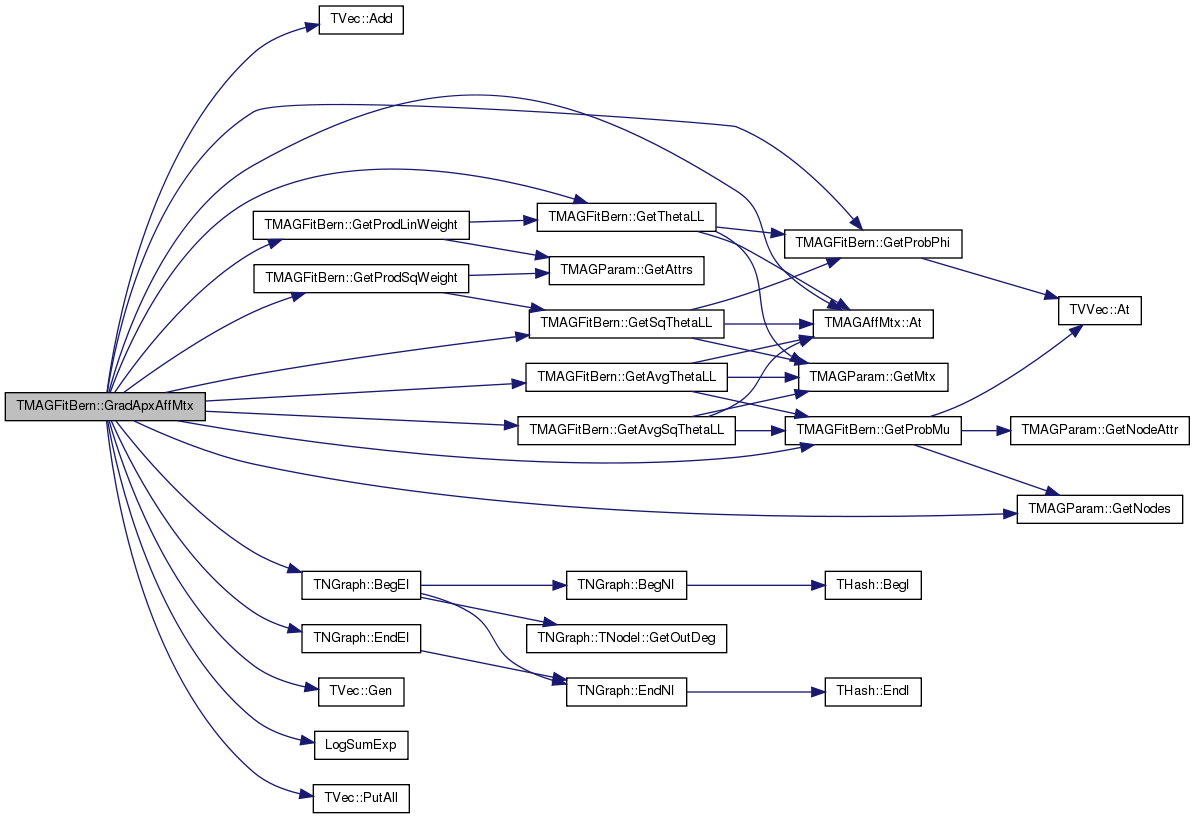

| const double TMAGFitBern::GradPhiMI | ( | const double & | x, |
| const int & | NId, | ||
| const int & | AId, | ||
| const double & | Lambda, | ||
| const double & | DeltaQ, | ||
| const TFltVV & | CntVV | ||
| ) |
Definition at line 703 of file mag.cpp.
References TVVec< TVal >::GetYDim(), and PhiVV.
Referenced by UpdateApxPhiMI(), and UpdatePhiMI().
{
const int NAttrs = CntVV.GetYDim();
double Grad = DeltaQ - log(x) + log(1.0-x);
for(int l = 0; l < NAttrs; l++) {
if(l == AId) { continue; }
const double C0 = PhiVV(NId, l);
const double C1 = 1.0 - C0;
Grad -= Lambda * C0 * log(CntVV(0, l) + C0 * x);
Grad -= Lambda * C1 * log(CntVV(1, l) + C1 * x);
Grad += Lambda * C0 * log(CntVV(2, l) + C0 * (1-x));
Grad += Lambda * C1 * log(CntVV(3, l) + C1 * (1-x));
Grad -= Lambda * log(CntVV(0, l) + CntVV(1, l) + x);
Grad += Lambda * log(CntVV(2, l) + CntVV(3, l) + (1-x));
}
return Grad;
}


| void TMAGFitBern::Init | ( | const TFltV & | MuV, |
| const TMAGAffMtxV & | AffMtxV | ||
| ) |
Definition at line 452 of file mag.cpp.
References TVVec< TVal >::Gen(), TMAGParam< TNodeAttr >::GetAttrs(), TMAGParam< TNodeAttr >::GetNodes(), KnownVV, Param, PhiVV, TVVec< TVal >::PutAll(), TMAGParam< TNodeAttr >::SetMtxV(), and TMAGParam< TNodeAttr >::SetNodeAttr().
{
TMAGNodeBern DistParam(MuV);
Param.SetNodeAttr(DistParam);
Param.SetMtxV(AffMtxV);
const int NNodes = Param.GetNodes();
const int NAttrs = Param.GetAttrs();
PhiVV.Gen(NNodes, NAttrs);
KnownVV.Gen(NNodes, NAttrs);
KnownVV.PutAll(false);
}
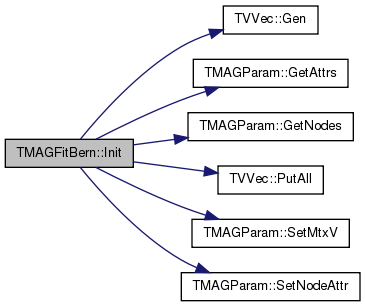
| void TMAGFitBern::MakeCCDF | ( | const TFltPrV & | RawV, |
| TFltPrV & | CcdfV | ||
| ) |
Definition at line 1703 of file mag.cpp.
References TVec< TVal >::Add(), TVec< TVal >::Gen(), IAssert, and TVec< TVal >::Len().
Referenced by PlotProperties().
{
double Total = 0.0;
CcdfV.Gen(RawV.Len(), 0);
for(int i = 0; i < RawV.Len(); i++) {
if(RawV[i].Val2 <= 0) { continue; }
Total += RawV[i].Val2;
CcdfV.Add(RawV[i]);
IAssert(RawV[i].Val2 > 0);
}
for(int i = 1; i < CcdfV.Len(); i++) {
CcdfV[i].Val2 += CcdfV[i-1].Val2;
}
for(int i = CcdfV.Len() - 1; i > 0; i--) {
CcdfV[i].Val2 = (Total - CcdfV[i-1].Val2) ;
if(CcdfV[i].Val2 <= 0) { printf("CCDF = %f\n", double(CcdfV[i].Val2));}
IAssert(CcdfV[i].Val2 > 0);
}
CcdfV[0].Val2 = Total;
// CcdfV[0].Val2 = 1.0;
}
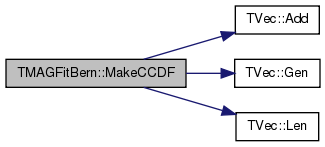

| const bool TMAGFitBern::NextPermutation | ( | TIntV & | IndexV | ) | const [private] |
Definition at line 1867 of file mag.cpp.
References TVec< TVal >::GetSubValV(), TVec< TVal >::Len(), and TVec< TVal >::Sort().
{
const int NAttrs = IndexV.Len();
int Pos = NAttrs - 1;
while(Pos > 0) {
if(IndexV[Pos-1] < IndexV[Pos]) {
break;
}
Pos--;
}
if(Pos == 0) {
return false;
}
int Val = NAttrs, NewPos = -1;
for(int i = Pos; i < NAttrs; i++) {
if(IndexV[i] > IndexV[Pos - 1] && IndexV[i] < Val) {
NewPos = i;
Val = IndexV[i];
}
}
IndexV[NewPos] = IndexV[Pos - 1];
IndexV[Pos - 1] = Val;
TIntV SubIndexV;
IndexV.GetSubValV(Pos, NAttrs - 1, SubIndexV);
SubIndexV.Sort(true);
for(int i = Pos; i < NAttrs; i++) {
IndexV[i] = SubIndexV[i - Pos];
}
return true;
}
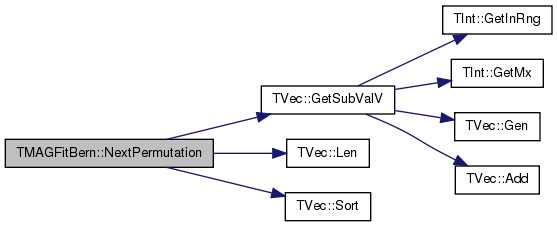
| void TMAGFitBern::NormalizeAffMtxV | ( | TMAGAffMtxV & | MtxV, |
| const bool | UseMu = false |
||
| ) |
Definition at line 1454 of file mag.cpp.
References AvgPhiV, TNGraph::GetEdges(), GetMuV(), TMAGParam< TNodeAttr >::GetNodes(), Graph, TVec< TVal >::Len(), NormConst, and Param.
Referenced by DoEMAlg(), UnNormalizeAffMtxV(), and UpdateAffMtxV().
{
const int NNodes = Param.GetNodes();
const int NAttrs = MtxV.Len();
TFltV MuV = GetMuV();
double Product = 1.0, ExpEdge = NNodes * (NNodes - 1);
TFltV SumV(NAttrs), EdgeSumV(NAttrs);
SumV.PutAll(0.0); EdgeSumV.PutAll(0.0);
for(int l = 0; l < NAttrs; l++) {
double Mu = (UseMu) ? double(MuV[l]) : (AvgPhiV[l] / double(NNodes));
EdgeSumV[l] += Mu * Mu * MtxV[l].At(0, 0);
EdgeSumV[l] += Mu * (1.0-Mu) * MtxV[l].At(0, 1);
EdgeSumV[l] += Mu * (1.0-Mu) * MtxV[l].At(1, 0);
EdgeSumV[l] += (1.0-Mu) * (1.0-Mu) * MtxV[l].At(1, 1);
SumV[l] = SumV[l] + MtxV[l].At(0, 0);
SumV[l] = SumV[l] + MtxV[l].At(0, 1);
SumV[l] = SumV[l] + MtxV[l].At(1, 0);
SumV[l] = SumV[l] + MtxV[l].At(1, 1);
Product *= SumV[l];
ExpEdge *= EdgeSumV[l];
}
ExpEdge = Graph->GetEdges() / ExpEdge;
NormConst *= Product;
// NormConst = ExpEdge;
Product = 1.0;
// Product = pow(Product * ExpEdge, 1.0 / double(NAttrs));
for(int l = 0; l < NAttrs; l++) {
for(int p = 0; p < 4; p++) {
MtxV[l].At(p) = MtxV[l].At(p) * Product / SumV[l];
// MtxV[l].At(p) = MtxV[l].At(p) * Product / MtxV[l].At(0, 0);
// MtxV[l].At(p) = MtxV[l].At(p) * Product;
// if(MtxV[l].At(p) > 0.9999) { MtxV[l].At(p) = 0.9999; }
// if(MtxV[l].At(p) < 0.0001) { MtxV[l].At(p) = 0.0001; }
}
}
}
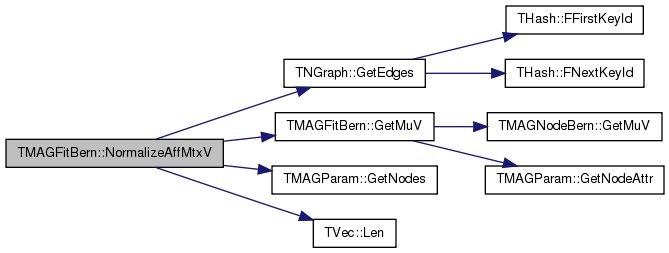

| const double TMAGFitBern::ObjPhiMI | ( | const double & | x, |
| const int & | NId, | ||
| const int & | AId, | ||
| const double & | Lambda, | ||
| const double & | Q0, | ||
| const double & | Q1, | ||
| const TFltVV & | CntVV | ||
| ) |
Definition at line 722 of file mag.cpp.
References TVVec< TVal >::GetYDim(), and PhiVV.
Referenced by UpdateApxPhiMI(), and UpdatePhiMI().
{
const int NAttrs = CntVV.GetYDim();
double Val = x*(Q0 - log(x)) + (1-x)*(Q1 - log(1.0-x));
for(int l = 0; l < NAttrs; l++) {
if(l == AId) { continue; }
const double C0 = PhiVV(NId, l);
const double C1 = 1.0 - C0;
Val -= Lambda * (CntVV(0, l) + C0 * x) * log(CntVV(0, l) + C0 * x);
Val -= Lambda * (CntVV(1, l) + C1 * x) * log(CntVV(1, l) + C1 * x);
Val -= Lambda * (CntVV(2, l) + C0 * (1-x)) * log(CntVV(2, l) + C0 * (1-x));
Val -= Lambda * (CntVV(3, l) + C1 * (1-x)) * log(CntVV(3, l) + C1 * (1-x));
Val += Lambda * (CntVV(0, l) + CntVV(1, l) + x) * log(CntVV(0, l) + CntVV(1, l) + x);
Val += Lambda * (CntVV(2, l) + CntVV(3, l) + 1 - x) * log(CntVV(2, l) + CntVV(3, l) + (1-x));
if(!(CntVV(0, l) > 0)) printf("CntVV(0, %d) = %.2f\n", l, double(CntVV(0, l)));
if(!(CntVV(1, l) > 0)) printf("CntVV(1, %d) = %.2f\n", l, double(CntVV(1, l)));
if(!(CntVV(2, l) > 0)) printf("CntVV(2, %d) = %.2f\n", l, double(CntVV(2, l)));
if(!(CntVV(3, l) > 0)) printf("CntVV(3, %d) = %.2f\n", l, double(CntVV(3, l)));
}
return Val;
}


| void TMAGFitBern::PlotProperties | ( | const TStr & | FNm | ) |
Definition at line 1727 of file mag.cpp.
References TGStatVec::Add(), TGnuPlot::AddCmd(), TGnuPlot::AddPlot(), TGStatVec::At(), TSnap::DelZeroDegNodes(), TMAGParam< TNodeAttr >::GenMAG(), TMAGParam< TNodeAttr >::GetAttrs(), TNGraph::GetEdges(), TMAGParam< TNodeAttr >::GetMtxV(), TMAGParam< TNodeAttr >::GetNodeAttr(), TMAGParam< TNodeAttr >::GetNodes(), gpsLog10XY, gpwLines, Graph, gsdClustCf, gsdHops, gsdInDeg, gsdOutDeg, gsdSngVal, gsdSngVec, gsdTriadPart, gsdWcc, TGStatVec::Len(), MakeCCDF(), Param, PhiVV, TGnuPlot::SaveEps(), TMAGParam< TNodeAttr >::SetMtxV(), TMAGParam< TNodeAttr >::SetNodeAttr(), TGnuPlot::SetScale(), TGnuPlot::SetXYLabel(), TGnuPlot::ShowGrid(), and tmuNodes.
{
const int NNodes = Param.GetNodes();
const int NAttrs = Param.GetAttrs();
TMAGParam<TMAGNodeBern> MAGGen(NNodes, NAttrs);
TMAGNodeBern MAGNode = Param.GetNodeAttr();
MAGGen.SetNodeAttr(MAGNode);
TMAGAffMtxV MtxV; Param.GetMtxV(MtxV);
MAGGen.SetMtxV(MtxV);
PNGraph TrG = new TNGraph;
*TrG = *Graph;
TIntVV AttrVV(NNodes, NAttrs);
for(int i = 0; i < NNodes; i++) {
for(int j = 0; j < NAttrs; j++) {
if(PhiVV(i, j) > TMAGNodeBern::Rnd.GetUniDev()) AttrVV(i, j) = 0;
else AttrVV(i, j) = 1;
}
}
PNGraph MAG = MAGGen.GenMAG(AttrVV, true, 10000);
// PNGraph MAG = MAGGen.GenAttrMAG(AttrVV, true, 10000);
printf("%d edges created for MAG...\n", MAG->GetEdges());
TSnap::DelZeroDegNodes(TrG);
TSnap::DelZeroDegNodes(MAG);
TGStatVec GS(tmuNodes, TFSet() | gsdInDeg | gsdOutDeg | gsdWcc | gsdHops | gsdClustCf | gsdSngVec | gsdSngVal | gsdTriadPart);
TGnuPlot InDegP(FNm + "-InDeg"), OutDegP(FNm + "-OutDeg"), SvalP(FNm + "-Sval"), SvecP(FNm + "-Svec"), WccP(FNm + "-Wcc"), HopP(FNm + "-Hop"), TriadP(FNm + "-Triad"), CcfP(FNm + "-Ccf");;
InDegP.SetXYLabel("Degree", "# of nodes");
OutDegP.SetXYLabel("Degree", "# of nodes");
SvalP.SetXYLabel("Rank", "Singular value");
SvecP.SetXYLabel("Rank", "Primary SngVec component");
WccP.SetXYLabel("Size of component", "# of components");
CcfP.SetXYLabel("Degree", "Clustering coefficient");
HopP.SetXYLabel("Hops", "# of node pairs");
TriadP.SetXYLabel("# of triads", "# of participating nodes");
InDegP.SetScale(gpsLog10XY); InDegP.AddCmd("set key top right");
OutDegP.SetScale(gpsLog10XY); OutDegP.AddCmd("set key top right");
SvalP.SetScale(gpsLog10XY); SvalP.AddCmd("set key top right");
SvecP.SetScale(gpsLog10XY); SvecP.AddCmd("set key top right");
CcfP.SetScale(gpsLog10XY); CcfP.AddCmd("set key top right");
HopP.SetScale(gpsLog10XY); HopP.AddCmd("set key top right");
TriadP.SetScale(gpsLog10XY); TriadP.AddCmd("set key top right");
InDegP.ShowGrid(false);
OutDegP.ShowGrid(false);
SvalP.ShowGrid(false);
SvecP.ShowGrid(false);
CcfP.ShowGrid(false);
HopP.ShowGrid(false);
TriadP.ShowGrid(false);
const TStr Style[2] = {"lt 1 lw 3 lc rgb 'black'", "lt 2 lw 3 lc rgb 'red'"};
const TStr Name[2] = {"Real", "MAG"};
GS.Add(Graph, TSecTm(1), "Real Graph");
GS.Add(MAG, TSecTm(2), "MAG");
TFltPrV InDegV, OutDegV, SvalV, SvecV, HopV, WccV, CcfV, TriadV;
for(int i = 0; i < GS.Len(); i++) {
MakeCCDF(GS.At(i)->GetDistr(gsdInDeg), InDegV);
MakeCCDF(GS.At(i)->GetDistr(gsdOutDeg), OutDegV);
SvalV = GS.At(i)->GetDistr(gsdSngVal);
SvecV = GS.At(i)->GetDistr(gsdSngVec);
MakeCCDF(GS.At(i)->GetDistr(gsdClustCf), CcfV);
HopV = GS.At(i)->GetDistr(gsdHops);
MakeCCDF(GS.At(i)->GetDistr(gsdTriadPart), TriadV);
InDegP.AddPlot(InDegV, gpwLines, Name[i], Style[i]);
OutDegP.AddPlot(OutDegV, gpwLines, Name[i], Style[i]);
SvalP.AddPlot(SvalV, gpwLines, Name[i], Style[i]);
SvecP.AddPlot(SvecV, gpwLines, Name[i], Style[i]);
CcfP.AddPlot(CcfV, gpwLines, Name[i], Style[i]);
HopP.AddPlot(HopV, gpwLines, Name[i], Style[i]);
TriadP.AddPlot(TriadV, gpwLines, Name[i], Style[i]);
}
InDegP.SaveEps(30);
OutDegP.SaveEps(30);
SvalP.SaveEps(30);
SvecP.SaveEps(30);
CcfP.SaveEps(30);
HopP.SaveEps(30);
TriadP.SaveEps(30);
}
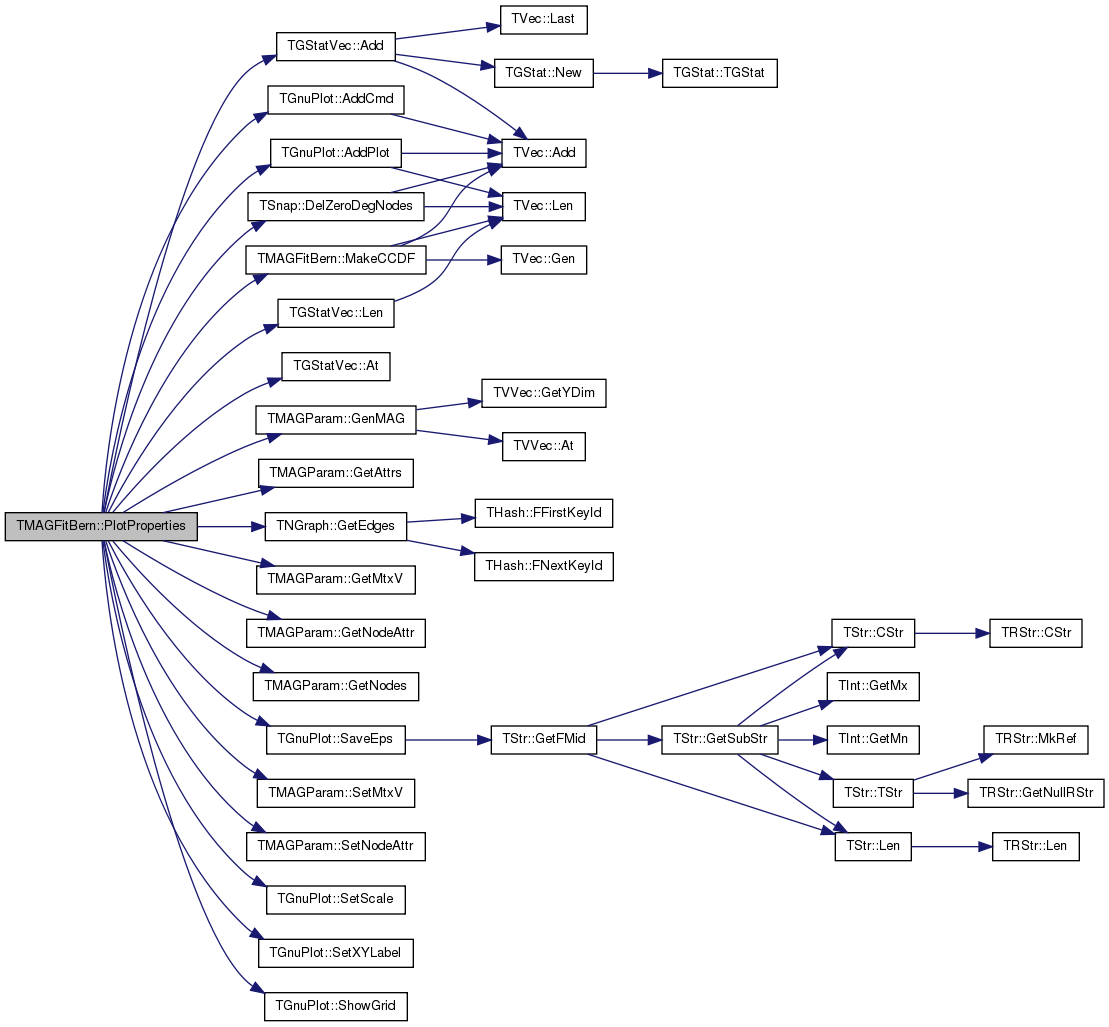
| const void TMAGFitBern::PrepareUpdateAffMtx | ( | TFltVV & | ProdVV, |
| TFltVV & | SqVV | ||
| ) |
Definition at line 1532 of file mag.cpp.
References TVVec< TVal >::Gen(), TMAGParam< TNodeAttr >::GetNodes(), GetProdLinWeight(), GetProdSqWeight(), and Param.
Referenced by UpdateAffMtxV().
{
const int NNodes = Param.GetNodes();
ProdVV.Gen(NNodes, NNodes);
SqVV.Gen(NNodes, NNodes);
for(int i = 0; i < NNodes; i++) {
for(int j = 0; j < NNodes; j++) {
ProdVV(i, j) = GetProdLinWeight(i, j);
SqVV(i, j) = GetProdSqWeight(i, j);
}
}
}


| const void TMAGFitBern::PrepareUpdateApxAffMtx | ( | TFltVV & | ProdVV, |
| TFltVV & | SqVV | ||
| ) |
Definition at line 1545 of file mag.cpp.
References TVVec< TVal >::Gen(), GetAvgProdLinWeight(), GetAvgProdSqWeight(), TMAGParam< TNodeAttr >::GetNodes(), and Param.
Referenced by UpdateAffMtxV().
{
const int NNodes = Param.GetNodes();
ProdVV.Gen(NNodes, 2);
SqVV.Gen(NNodes, 2);
for(int i = 0; i < NNodes; i++) {
ProdVV(i, 0) = GetAvgProdLinWeight(i, i, true, false);
ProdVV(i, 1) = GetAvgProdLinWeight(i, i, false, true);
SqVV(i, 0) = GetAvgProdSqWeight(i, i, true, false);
SqVV(i, 1) = GetAvgProdSqWeight(i, i, false, true);
}
}


| void TMAGFitBern::RandomInit | ( | const TFltV & | MuV, |
| const TMAGAffMtxV & | AffMtxV, | ||
| const int & | Seed | ||
| ) |
Definition at line 510 of file mag.cpp.
References TVVec< TVal >::At(), TVVec< TVal >::Gen(), TMAGParam< TNodeAttr >::GetAttrs(), TMAGParam< TNodeAttr >::GetNodes(), TRnd::GetUniDev(), KnownVV, Param, PhiVV, TVec< TVal >::PutAll(), TVVec< TVal >::PutAll(), TRnd::PutSeed(), TMAGParam< TNodeAttr >::SetMtxV(), and TMAGParam< TNodeAttr >::SetNodeAttr().
{
TRnd& Rnd = TMAGNodeBern::Rnd;
Rnd.PutSeed(Seed);
TFltV InitMuV = MuV; InitMuV.PutAll(0.5);
TMAGNodeBern DistParam(InitMuV);
Param.SetMtxV(AffMtxV);
const int NNodes = Param.GetNodes();
const int NAttrs = Param.GetAttrs();
PhiVV.Gen(NNodes, NAttrs);
KnownVV.Gen(NNodes, NAttrs);
KnownVV.PutAll(false);
for(int i = 0; i < NNodes; i++) {
for(int l = 0; l < NAttrs; l++) {
PhiVV.At(i, l) = Rnd.GetUniDev();
// PhiVV.At(i, l) = 0.5;
}
}
TMAGAffMtxV RndMtxV = AffMtxV;
for(int l = 0; l < NAttrs; l++) {
for(int p = 0; p < 4; p++) {
RndMtxV[l].At(p) = TMAGNodeBern::Rnd.GetUniDev();
if(RndMtxV[l].At(p) < 0.1) { RndMtxV[l].At(p) = 0.1; }
if(RndMtxV[l].At(p) > 0.9) { RndMtxV[l].At(p) = 0.9; }
}
RndMtxV[l].At(0, 1) = RndMtxV[l].At(1, 0);
}
printf("\n");
for(int l = 0; l < NAttrs; l++) {
printf("AffMtx = %s\n", RndMtxV[l].GetMtxStr().GetCStr());
}
Param.SetMtxV(RndMtxV);
Param.SetNodeAttr(DistParam);
}
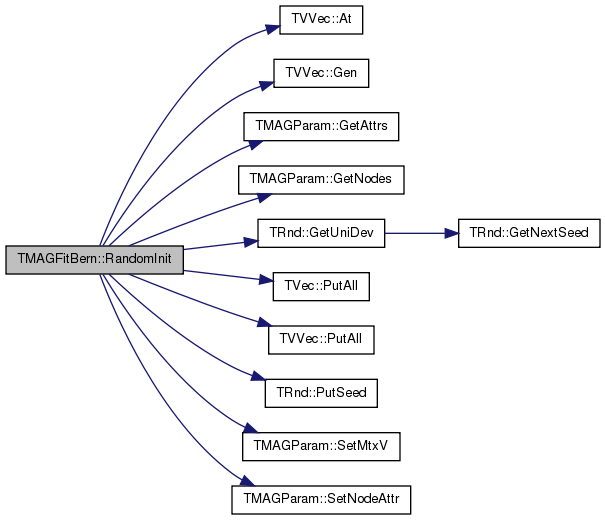
| void TMAGFitBern::SaveTxt | ( | const TStr & | FNm | ) |
Definition at line 423 of file mag.cpp.
References TMAGParam< TNodeAttr >::GetAttrs(), TStr::GetCStr(), TMAGParam< TNodeAttr >::GetMtxV(), GetMuV(), TMAGParam< TNodeAttr >::GetNodes(), Param, and PhiVV.
{
const int NNodes = Param.GetNodes();
const int NAttrs = Param.GetAttrs();
const TFltV MuV = GetMuV();
TMAGAffMtxV MtxV;
Param.GetMtxV(MtxV);
FILE *fp = fopen(FNm.GetCStr(), "w");
for(int l = 0; l < NAttrs; l++) {
fprintf(fp, "%.4f\t", double(MuV[l]));
for(int row = 0; row < 2; row++) {
for(int col = 0; col < 2; col++) {
fprintf(fp, " %.4f", double(MtxV[l].At(row, col)));
}
fprintf(fp, (row == 0) ? ";" : "\n");
}
}
fclose(fp);
fp = fopen((FNm + "f").CStr(), "w");
for(int i = 0; i < NNodes; i++) {
for(int l = 0; l < NAttrs; l++) {
fprintf(fp, "%f ", double(PhiVV(i, l)));
}
fprintf(fp, "\n");
}
fclose(fp);
}
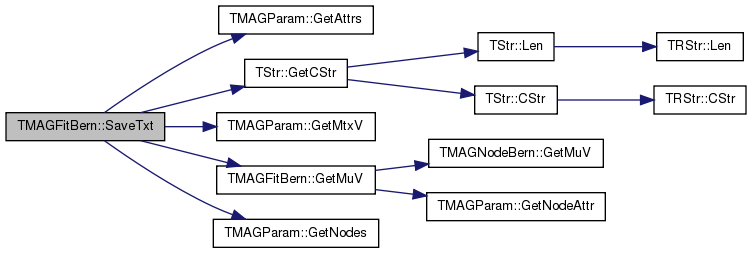
| void TMAGFitBern::SetAlgConf | ( | const bool | EStep = true, |
| const bool | MStep = true |
||
| ) | [inline] |
| void TMAGFitBern::SetDebug | ( | const bool | _Debug | ) | [inline] |
| void TMAGFitBern::SetGraph | ( | const PNGraph & | GraphPt | ) |
Definition at line 385 of file mag.cpp.
References TNGraph::GetNIdV(), TNGraph::GetNodes(), TSnap::GetSubGraph(), Graph, IAssert, and TNGraph::IsNode().
Referenced by TMAGFitBern().
{
Graph = GraphPt;
bool NodesOk = true;
// check that nodes IDs are {0,1,..,Nodes-1}
for (int nid = 0; nid < Graph->GetNodes(); nid++) {
if (! Graph->IsNode(nid)) { NodesOk=false; break; } }
if (! NodesOk) {
TIntV NIdV; GraphPt->GetNIdV(NIdV);
Graph = TSnap::GetSubGraph(GraphPt, NIdV, true);
for (int nid = 0; nid < Graph->GetNodes(); nid++) {
IAssert(Graph->IsNode(nid)); }
}
}
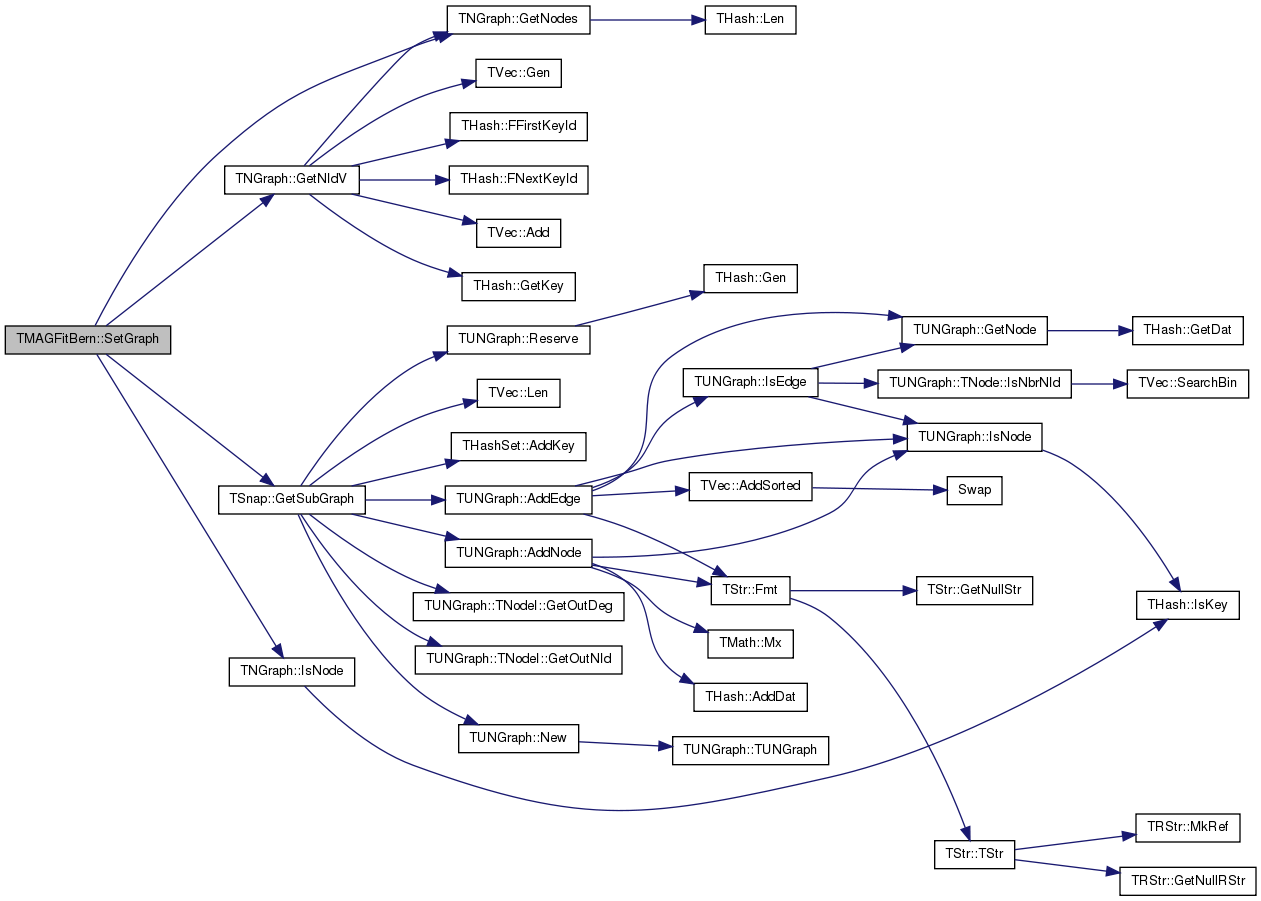

| void TMAGFitBern::SetMtxV | ( | const TMAGAffMtxV & | MtxV | ) | [inline] |
| void TMAGFitBern::SetMuV | ( | const TFltV & | MuV | ) | [inline] |
Definition at line 380 of file mag.h.
References TMAGParam< TNodeAttr >::GetNodeAttr(), Param, TMAGNodeBern::SetMuV(), and TMAGParam< TNodeAttr >::SetNodeAttr().
{ TMAGNodeBern Dist = Param.GetNodeAttr(); Dist.SetMuV(MuV); Param.SetNodeAttr(Dist); }

| void TMAGFitBern::SetPhiVV | ( | const TIntVV & | AttrVV, |
| const int | KnownIds = 0 |
||
| ) |
Definition at line 399 of file mag.cpp.
References TVVec< TVal >::Gen(), TMAGParam< TNodeAttr >::GetAttrs(), TMAGParam< TNodeAttr >::GetNodes(), KnownVV, Param, PhiVV, and TVVec< TVal >::PutY().
{
const int NNodes = Param.GetNodes();
const int NAttrs = Param.GetAttrs();
PhiVV.Gen(NNodes, NAttrs);
KnownVV.Gen(NNodes, NAttrs);
for(int l = 0; l < NAttrs; l++) {
for(int i = 0; i < NNodes; i++) {
if(int(AttrVV(i, l)) == 0) {
PhiVV(i, l) = 0.9999;
} else {
PhiVV(i, l) = 0.0001;
}
}
if(l < KnownIds) {
KnownVV.PutY(l, true);
} else {
KnownVV.PutY(l, false);
}
}
}
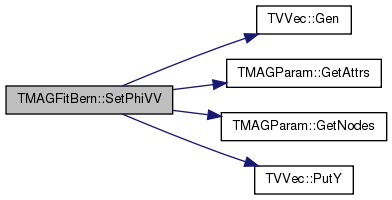
| void TMAGFitBern::SetPhiVV | ( | const TFltVV & | AttrVV, |
| const int | KnownIds = 0 |
||
| ) | [inline] |
Definition at line 394 of file mag.h.
References TVVec< TVal >::Gen(), TVVec< TVal >::GetXDim(), TVVec< TVal >::GetYDim(), KnownVV, PhiVV, TVVec< TVal >::PutAll(), and TVVec< TVal >::PutY().
{ PhiVV = AttrVV; KnownVV.Gen(PhiVV.GetXDim(), PhiVV.GetYDim()); KnownVV.PutAll(false); for(int i = 0; i < KnownIds; i++) { KnownVV.PutY(i, true); } }
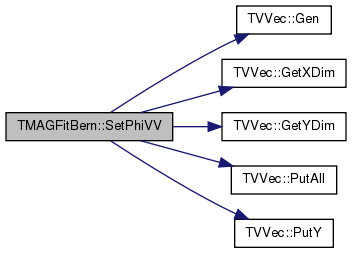
| void TMAGFitBern::SortAttrOrdering | ( | const TFltV & | TrueMuV, |
| TIntV & | IndexV | ||
| ) | const |
Definition at line 1828 of file mag.cpp.
References CountAttr(), TVec< TVal >::Gen(), TVec< TVal >::Len(), and TVec< TVal >::Swap().
{
const int NAttrs = TrueMuV.Len();
// const int NNodes = PhiVV.GetXDim();
TFltV EstMuV, SortedTrueMuV, SortedEstMuV, TrueIdxV, EstIdxV;
IndexV.Gen(NAttrs);
TrueIdxV.Gen(NAttrs);
EstIdxV.Gen(NAttrs);
for(int l = 0; l < NAttrs; l++) {
TrueIdxV[l] = l;
EstIdxV[l] = l;
}
CountAttr(EstMuV);
SortedTrueMuV = TrueMuV;
SortedEstMuV = EstMuV;
for(int i = 0; i < NAttrs; i++) {
if(SortedTrueMuV[i] > 0.5) { SortedTrueMuV[i] = 1.0 - SortedTrueMuV[i]; }
if(SortedEstMuV[i] > 0.5) { SortedEstMuV[i] = 1.0 - SortedEstMuV[i]; }
}
for(int i = 0; i < NAttrs; i++) {
for(int j = i+1; j < NAttrs; j++) {
if(SortedTrueMuV[i] < SortedTrueMuV[j]) {
SortedTrueMuV.Swap(i, j);
TrueIdxV.Swap(i, j);
}
if(SortedEstMuV[i] < SortedEstMuV[j]) {
EstIdxV.Swap((int)SortedEstMuV[i], (int)SortedEstMuV[j]);
SortedEstMuV.Swap(i, j);
}
}
}
for(int l = 0; l < NAttrs; l++) {
IndexV[l] = (int)TrueIdxV[(int)EstIdxV[l]];
}
}
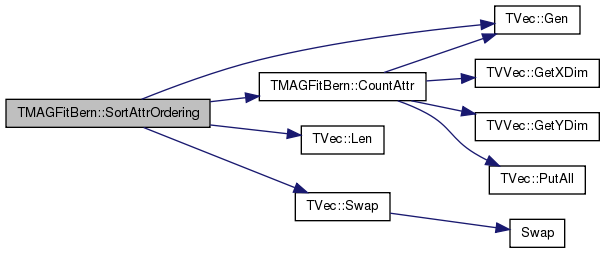
| void TMAGFitBern::UnNormalizeAffMtxV | ( | TMAGAffMtxV & | MtxV, |
| const bool | UseMu = false |
||
| ) |
Definition at line 1492 of file mag.cpp.
References TNGraph::GetEdges(), GetMuV(), TMAGParam< TNodeAttr >::GetNodes(), Graph, TVec< TVal >::Len(), NormalizeAffMtxV(), NormConst, Param, and TVec< TVal >::Sort().
Referenced by DoEMAlg().
{
const int NNodes = Param.GetNodes();
const int NAttrs = MtxV.Len();
TFltIntPrV MaxEntV(NAttrs);
TFltV MuV = GetMuV();
NormalizeAffMtxV(MtxV, UseMu);
double ExpEdge = NNodes * (NNodes - 1);
for(int l = 0; l < NAttrs; l++) {
double Mu = MuV[l];
double EdgeSum = Mu * Mu * MtxV[l].At(0, 0);
EdgeSum += Mu * (1.0-Mu) * MtxV[l].At(0, 1);
EdgeSum += Mu * (1.0-Mu) * MtxV[l].At(1, 0);
EdgeSum += (1.0-Mu) * (1.0-Mu) * MtxV[l].At(1, 1);
ExpEdge *= EdgeSum;
}
NormConst = double(Graph->GetEdges()) / ExpEdge;
// NormConst *= ExpEdge;
for(int l = 0; l < NAttrs; l++) {
MaxEntV[l] = TFltIntPr(-1, l);
for(int p = 0; p < 4; p++) {
if(MaxEntV[l].Val1 < MtxV[l].At(p)) { MaxEntV[l].Val1 = MtxV[l].At(p); }
}
}
MaxEntV.Sort(false);
for(int l = 0; l < NAttrs; l++) {
int CurId = MaxEntV[l].Val2;
double Factor = pow(NormConst, 1.0 / double(NAttrs - l));
double MaxFactor = 0.9999 / MaxEntV[l].Val1;
Factor = (Factor > MaxFactor) ? MaxFactor : Factor;
NormConst = NormConst / Factor;
for(int p = 0; p < 4; p++) {
MtxV[CurId].At(p) = MtxV[CurId].At(p) * Factor;
}
}
}
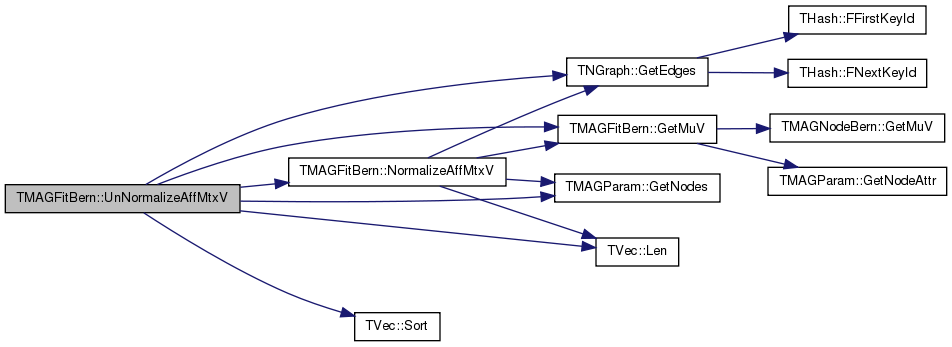

| const double TMAGFitBern::UpdateAffMtx | ( | const int & | AId, |
| const double & | LrnRate, | ||
| const double & | MaxGrad, | ||
| const double & | Lambda, | ||
| TFltVV & | ProdVV, | ||
| TFltVV & | SqVV, | ||
| TMAGAffMtx & | NewMtx | ||
| ) |
Definition at line 1418 of file mag.cpp.
References TMAGAffMtx::At(), TMAGParam< TNodeAttr >::GetMtx(), TMAGAffMtx::GetMtxStr(), GradAffMtx(), GradApxAffMtx(), MSpeedUp, and Param.
Referenced by UpdateAffMtxV().
{
double Delta = 0.0;
// const int NNodes = Param.GetNodes();
// const int NAttrs = Param.GetAttrs();
TMAGAffMtx AffMtx = Param.GetMtx(AId);
TFltV GradV(4);
TFltV HessV(4);
if(MSpeedUp) {
GradApxAffMtx(AId, ProdVV, SqVV, NewMtx, GradV);
} else {
GradAffMtx(AId, ProdVV, SqVV, NewMtx, GradV);
}
double Ratio = 1.0;
for(int p = 0; p < 4; p++) {
if(fabs(Ratio * LrnRate * GradV[p]) > MaxGrad) {
Ratio = MaxGrad / fabs(LrnRate * GradV[p]);
}
}
for(int p = 0; p < 4; p++) {
GradV[p] *= (Ratio * LrnRate);
NewMtx.At(p) = AffMtx.At(p) + GradV[p];
// if(NewMtx.At(p) > 0.9999) { NewMtx.At(p) = 0.9999; }
if(NewMtx.At(p) < 0.0001) { NewMtx.At(p) = 0.0001; }
}
printf(" [Attr = %d]\n", AId);
printf(" %s + [%f, %f; %f %f] -----> %s\n", (AffMtx.GetMtxStr()).GetCStr(), double(GradV[0]), double(GradV[1]), double(GradV[2]), double(GradV[3]), (NewMtx.GetMtxStr()).GetCStr());
// Param.SetMtx(AId, NewMtx);
return Delta;
}
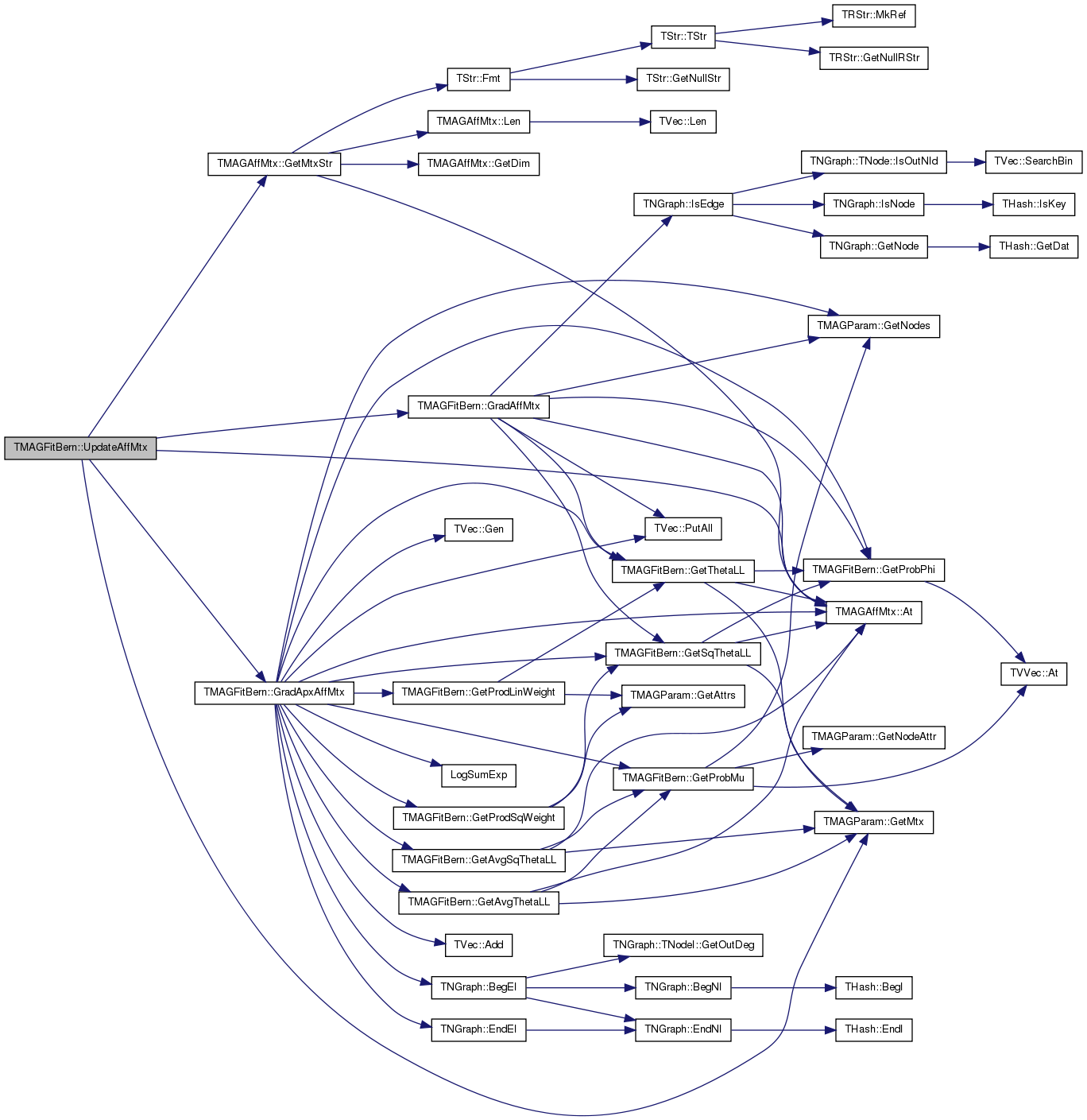

| const double TMAGFitBern::UpdateAffMtxV | ( | const int & | GradIter, |
| const double & | LrnRate, | ||
| const double & | MaxGrad, | ||
| const double & | Lambda, | ||
| const int & | NReal = 0 |
||
| ) |
Definition at line 1558 of file mag.cpp.
References TVVec< TVal >::Clr(), TMAGParam< TNodeAttr >::GetAttrs(), TMAGParam< TNodeAttr >::GetMtxV(), TMAGNodeBern::GetMuV(), TMAGParam< TNodeAttr >::GetNodeAttr(), TMAGParam< TNodeAttr >::GetNodes(), MSpeedUp, NormalizeAffMtxV(), Param, PrepareUpdateAffMtx(), PrepareUpdateApxAffMtx(), TMAGParam< TNodeAttr >::SetMtxV(), and UpdateAffMtx().
Referenced by DoMStep().
{
const int NNodes = Param.GetNodes();
const int NAttrs = Param.GetAttrs();
const TMAGNodeBern DistParam = Param.GetNodeAttr();
const TFltV MuV = DistParam.GetMuV();
double Delta = 0.0;
double DecLrnRate = LrnRate, DecMaxGrad = MaxGrad;
TFltVV ProdVV(NNodes, NNodes), SqVV(NNodes, NNodes);
TMAGAffMtxV NewMtxV, OldMtxV;
Param.GetMtxV(OldMtxV);
Param.GetMtxV(NewMtxV);
for(int g = 0; g < GradIter; g++) {
if(MSpeedUp) {
PrepareUpdateApxAffMtx(ProdVV, SqVV);
} else {
PrepareUpdateAffMtx(ProdVV, SqVV);
}
printf(" [Grad step = %d]\n", (g+1));
// for(int l = 0; l < NAttrs; l++) {
for(int l = NReal; l < NAttrs; l++) {
UpdateAffMtx(l, DecLrnRate, DecMaxGrad, Lambda, ProdVV, SqVV, NewMtxV[l]);
Param.SetMtxV(NewMtxV);
}
DecLrnRate *= 0.97;
DecMaxGrad *= 0.97;
printf("\n");
NormalizeAffMtxV(NewMtxV, true);
Param.SetMtxV(NewMtxV);
}
NormalizeAffMtxV(NewMtxV, true);
printf( "\nFinal\n");
for(int l = 0; l < NAttrs; l++) {
printf(" [");
for(int p = 0; p < 4; p++) {
// NewMtxV[l].At(p) = NewMtxV[l].At(p) * Product / SumV[l];
Delta += fabs(OldMtxV[l].At(p) - NewMtxV[l].At(p));
printf(" %.4f ", double(NewMtxV[l].At(p)));
}
printf("]\n");
}
Param.SetMtxV(NewMtxV);
ProdVV.Clr(); SqVV.Clr();
return Delta;
}
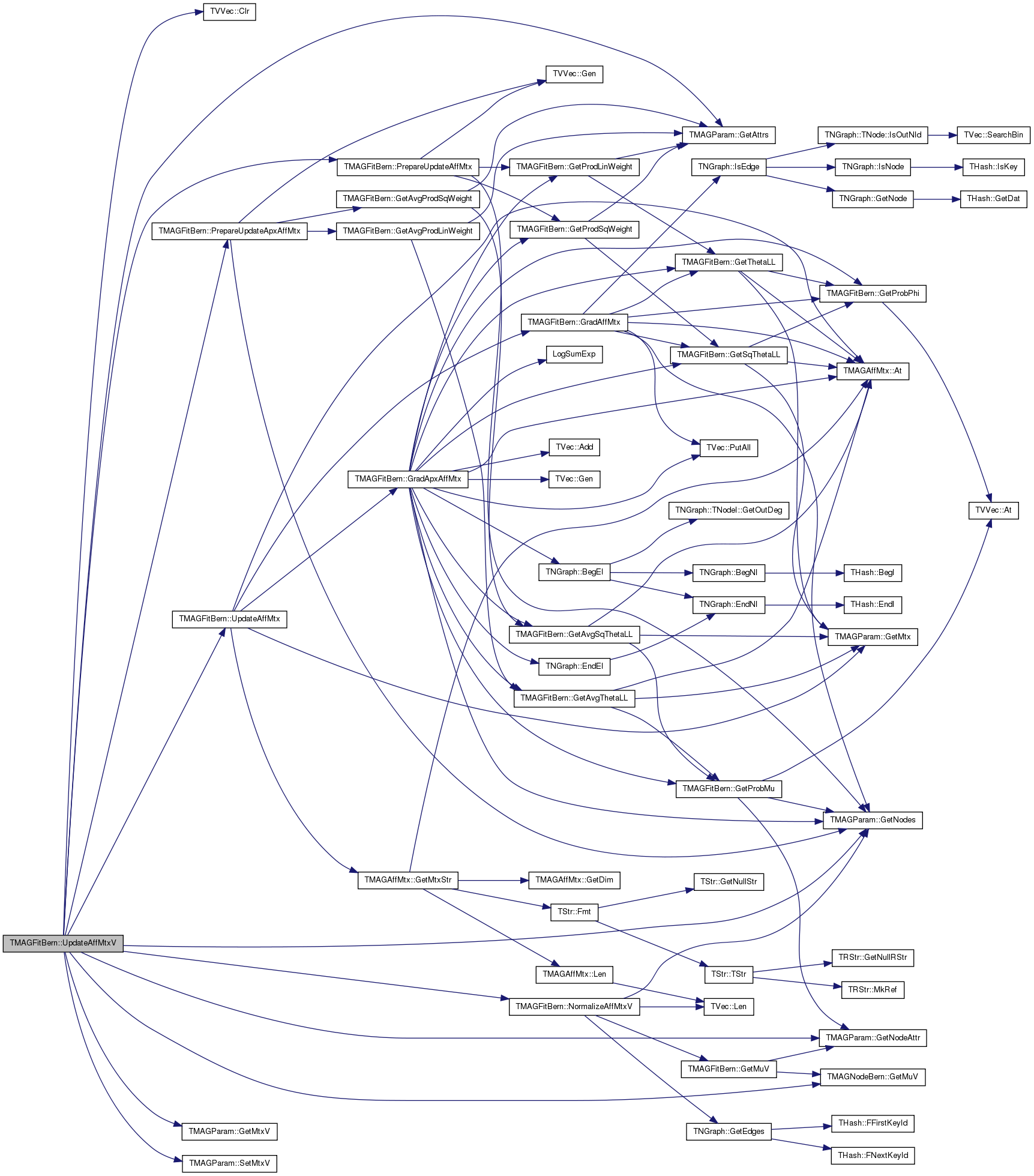

| const double TMAGFitBern::UpdateApxPhiMI | ( | const double & | Lambda, |
| const int & | NId, | ||
| const int & | AId, | ||
| double & | Phi, | ||
| TFltVV & | ProdVV | ||
| ) |
Definition at line 930 of file mag.cpp.
References TVec< TVal >::Add(), TMAGAffMtx::At(), TVVec< TVal >::At(), AvgPhiPairVV, TVec< TVal >::Gen(), TMAGParam< TNodeAttr >::GetAttrs(), GetAvgInCoeff(), GetAvgOutCoeff(), GetAvgSqThetaLL(), GetAvgThetaLL(), GetInCoeff(), TNGraph::TNodeI::GetInDeg(), TNGraph::TNodeI::GetInNId(), TMAGAffMtx::GetLLMtx(), TMAGParam< TNodeAttr >::GetMtx(), TMAGNodeBern::GetMu(), TNGraph::GetNI(), TMAGParam< TNodeAttr >::GetNodeAttr(), TMAGParam< TNodeAttr >::GetNodes(), GetOutCoeff(), TNGraph::TNodeI::GetOutDeg(), TNGraph::TNodeI::GetOutNId(), GetProdLinWeight(), GetProdSqWeight(), TVVec< TVal >::GetRow(), GetSqThetaLL(), GetThetaLL(), GradPhiMI(), Graph, IAssert, TMAGAffMtx::Len(), TVec< TVal >::Len(), LogSumExp(), ObjPhiMI(), Param, PhiVV, and TVVec< TVal >::PutAll().
Referenced by DoEStepApxOneIter().
{
TMAGAffMtx LLTheta, Theta = Param.GetMtx(AId);
const int NNodes = Param.GetNodes();
const int NAttrs = Param.GetAttrs();
Theta.GetLLMtx(LLTheta);
TMAGNodeBern DistParam = Param.GetNodeAttr();
const double Mu = DistParam.GetMu(AId);
TMAGAffMtx SqTheta(Theta);
for(int i = 0; i < Theta.Len(); i++) {
SqTheta.At(i) = SqTheta.At(i) * SqTheta.At(i);
}
TFltV ProdV; ProdVV.GetRow(NId, ProdV);
ProdV[0] -= GetAvgThetaLL(NId, NId, AId, true, false);
ProdV[1] -= GetAvgThetaLL(NId, NId, AId, false, true);
ProdV[2] -= log(2.0) + GetAvgSqThetaLL(NId, NId, AId, true, false);
ProdV[3] -= log(2.0) + GetAvgSqThetaLL(NId, NId, AId, false, true);
// Using log-sum-exp trick
double EdgeQ[2], MaxExp[2];
TFltV NonEdgeLLV[2];
TFltVV CntVV(4, NAttrs); CntVV.PutAll(0.0);
for(int i = 0; i < 2; i++) {
EdgeQ[i] = 0.0;
MaxExp[i] = -DBL_MAX;
NonEdgeLLV[i].Gen(4 * NNodes, 0);
}
for(int F = 0; F < 2; F++) {
NonEdgeLLV[F].Add(ProdV[0] + log(GetAvgOutCoeff(NId, AId, F, Theta)));
NonEdgeLLV[F].Add(ProdV[1] + log(GetAvgInCoeff(NId, AId, F, Theta)));
NonEdgeLLV[F].Add(ProdV[2] + log(GetAvgOutCoeff(NId, AId, F, SqTheta)));
NonEdgeLLV[F].Add(ProdV[3] + log(GetAvgInCoeff(NId, AId, F, SqTheta)));
}
EdgeQ[0] = -(NNodes - 1) * exp(LogSumExp(NonEdgeLLV[0]));
EdgeQ[1] = -(NNodes - 1) * exp(LogSumExp(NonEdgeLLV[1]));
for(int l = 0; l < NAttrs; l++) {
if(l == AId) { continue; }
int BgId = (AId > l) ? AId : l;
int SmId = (AId + l) - BgId;
int SmL = (l < AId) ? 1 : 0;
BgId *= 4;
CntVV(0, l) = AvgPhiPairVV(SmId, BgId) - PhiVV(NId, AId) * PhiVV(NId, l);
CntVV(1+SmL, l) = AvgPhiPairVV(SmId, BgId+1+SmL) - PhiVV(NId, AId) * (1.0-PhiVV(NId, l));
CntVV(2-SmL, l) = AvgPhiPairVV(SmId, BgId+2-SmL) - (1.0-PhiVV(NId, AId)) * PhiVV(NId, l);
CntVV(3, l) = AvgPhiPairVV(SmId, BgId+3) - (1.0-PhiVV(NId, AId)) * (1.0-PhiVV(NId, l));
}
TNGraph::TNodeI NI = Graph->GetNI(NId);
for(int d = 0; d < NI.GetOutDeg(); d++) {
int Out = NI.GetOutNId(d);
if(NId == Out) { continue; }
double LinW = GetProdLinWeight(NId, Out) - GetThetaLL(NId, Out, AId);
double SqW = GetProdSqWeight(NId, Out) - GetSqThetaLL(NId, Out, AId);
for(int F = 0; F < 2; F++) {
EdgeQ[F] += GetOutCoeff(NId, Out, AId, F, LLTheta);
EdgeQ[F] += exp(LinW + log(GetOutCoeff(NId, Out, AId, F, Theta)));
EdgeQ[F] += 0.5 * exp(SqW + log(GetOutCoeff(NId, Out, AId, F, SqTheta)));
}
}
for(int d = 0; d < NI.GetInDeg(); d++) {
int In = NI.GetInNId(d);
if(NId == In) { continue; }
double LinW = GetProdLinWeight(In, NId) - GetThetaLL(In, NId, AId);
double SqW = GetProdSqWeight(In, NId) - GetSqThetaLL(In, NId, AId);
for(int F = 0; F < 2; F++) {
EdgeQ[F] += GetInCoeff(In, NId, AId, F, LLTheta);
EdgeQ[F] += exp(LinW + log(GetInCoeff(In, NId, AId, F, Theta)));
EdgeQ[F] += 0.5 * exp(SqW + log(GetInCoeff(In, NId, AId, F, SqTheta)));
}
}
EdgeQ[0] += log(Mu);
EdgeQ[1] += log(1.0 - Mu);
double DeltaQ = EdgeQ[0] - EdgeQ[1];
// printf("(%d, %d) :: Q[0] = %f, Q[1] = %f\n", NId, AId, EdgeQ[0], EdgeQ[1]);
// double x[] = {0.1, 0.3, 0.5, 0.7, 0.9};
double x[] = {PhiVV(NId, AId)};
TFltV ObjValV; ObjValV.Gen(60, 0);
// for(int n = 0; n < 5; n++) {
for(int n = 0; n < 1; n++) {
// double LrnRate = 0.0002;
double LrnRate = 0.001;
for(int step = 0; step < 50; step++) {
// for(int step = 0; step < 10; step++) {
double Grad = GradPhiMI(x[n], NId, AId, Lambda, DeltaQ, CntVV);
if(Grad > 0.0) { x[n] += LrnRate; }
else { x[n] -= LrnRate; }
if(x[n] > 0.9999) { x[n] = 0.9999; }
if(x[n] < 0.0001) { x[n] = 0.0001; }
if(x[n] == 0.9999 || x[n] == 0.0001) {
break;
}
LrnRate *= 0.995;
}
ObjValV.Add(x[n]);
// ObjValV.Add(PhiVV(NId, AId));
}
double MaxVal = -DBL_MAX;
int MaxX = -1;
// for(int n = 0; n < 5; n++) {
for(int n = 0; n < ObjValV.Len(); n++) {
double Val = ObjPhiMI(ObjValV[n], NId, AId, Lambda, EdgeQ[0], EdgeQ[1], CntVV);
if(Val > MaxVal) {
MaxVal = Val;
MaxX = n;
} else if(MaxX < 0) {
printf("(%d, %d) : %f Q[0] = %f Q[1] = %f Val = %f\n", NId, AId, double(x[n]), double(EdgeQ[0]), double(EdgeQ[1]), Val);
}
}
IAssert(MaxX >= 0);
Phi = ObjValV[MaxX];
return Phi - PhiVV.At(NId, AId);
}
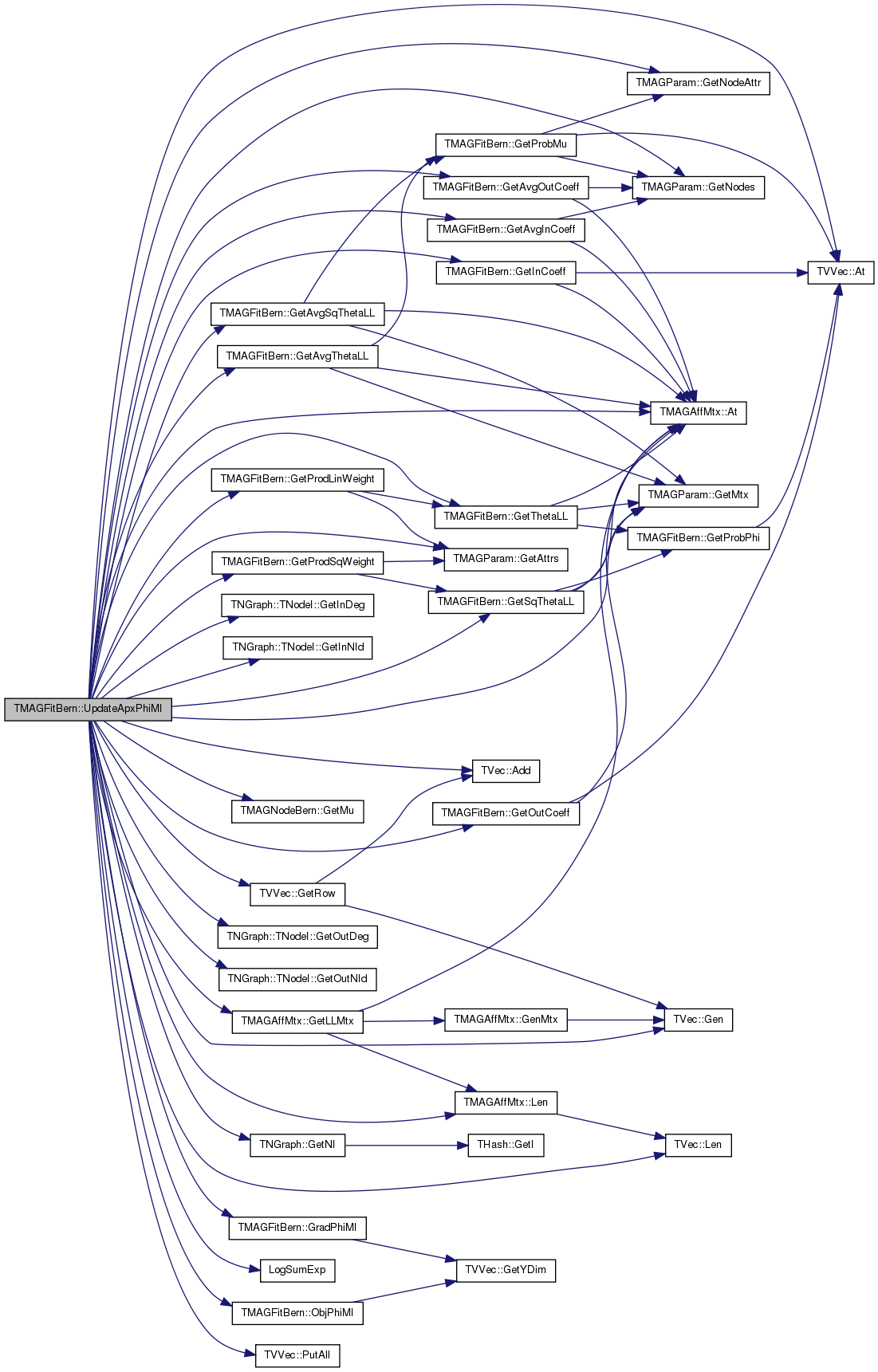

| const double TMAGFitBern::UpdateMu | ( | const int & | AId | ) |
Definition at line 1299 of file mag.cpp.
References TVVec< TVal >::At(), AvgPhiV, TMAGNodeBern::GetMu(), TMAGParam< TNodeAttr >::GetNodeAttr(), TMAGParam< TNodeAttr >::GetNodes(), Param, PhiVV, TMAGNodeBern::SetMu(), and TMAGParam< TNodeAttr >::SetNodeAttr().
Referenced by DoMStep().
{
const int NNodes = Param.GetNodes();
TMAGNodeBern DistParam = Param.GetNodeAttr();
const double OldMu = DistParam.GetMu(AId);
double NewMu = 0.0;
for(int i = 0; i < NNodes; i++) {
NewMu += PhiVV.At(i, AId);
}
AvgPhiV[AId] = NewMu;
NewMu /= double(NNodes);
printf(" [Posterior Mu] = %.4f\n", NewMu);
double Delta = fabs(NewMu - OldMu);
DistParam.SetMu(AId, NewMu);
Param.SetNodeAttr(DistParam);
return Delta;
}
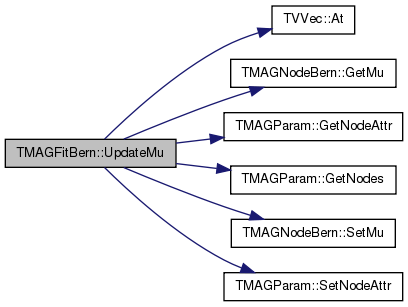

| const double TMAGFitBern::UpdatePhi | ( | const int & | NId, |
| const int & | AId, | ||
| double & | Phi | ||
| ) |
Definition at line 756 of file mag.cpp.
References TVec< TVal >::Add(), TMAGAffMtx::At(), TVVec< TVal >::At(), TVec< TVal >::Gen(), GetInCoeff(), TMAGAffMtx::GetLLMtx(), TMAGParam< TNodeAttr >::GetMtx(), TMAGNodeBern::GetMu(), TMAGParam< TNodeAttr >::GetNodeAttr(), TMAGParam< TNodeAttr >::GetNodes(), GetOutCoeff(), GetProdLinWeight(), GetProdSqWeight(), GetSqThetaLL(), GetThetaLL(), Graph, TNGraph::IsEdge(), TMAGAffMtx::Len(), LogSumExp(), Param, and PhiVV.
{
TMAGAffMtx LLTheta, Theta = Param.GetMtx(AId);
TMAGAffMtx SqTheta(Theta);
const int NNodes = Param.GetNodes();
// const int NAttrs = Param.GetAttrs();
Theta.GetLLMtx(LLTheta);
TMAGNodeBern DistParam = Param.GetNodeAttr();
const double Mu = DistParam.GetMu(AId);
for(int i = 0; i < Theta.Len(); i++) {
SqTheta.At(i) = SqTheta.At(i) * SqTheta.At(i);
}
// Using log-sum-exp trick
double EdgeQ[2], NonEdgeQ[2], MaxExp[2];
TFltV NonEdgeLLV[2];
for(int i = 0; i < 2; i++) {
EdgeQ[i] = 0.0;
NonEdgeQ[i] = 0.0;
MaxExp[i] = -DBL_MAX;
NonEdgeLLV[i].Gen(4 * NNodes, 0);
}
for(int j = 0; j < NNodes; j++) {
if(j == NId) { continue; }
if(Graph->IsEdge(NId, j)) {
EdgeQ[0] += GetOutCoeff(NId, j, AId, 0, LLTheta);
EdgeQ[1] += GetOutCoeff(NId, j, AId, 1, LLTheta);
} else {
double LinW = GetProdLinWeight(NId, j) - GetThetaLL(NId, j, AId);
double SqW = GetProdSqWeight(NId, j) - GetSqThetaLL(NId, j, AId);
for(int i = 0; i < 2; i++) {
NonEdgeLLV[i].Add(LinW + log(GetOutCoeff(NId, j, AId, i, Theta)));
NonEdgeLLV[i].Add(SqW + log(GetOutCoeff(NId, j, AId, i, SqTheta)) + log(0.5));
}
}
if(Graph->IsEdge(j, NId)) {
EdgeQ[0] += GetInCoeff(j, NId, AId, 0, LLTheta);
EdgeQ[1] += GetInCoeff(j, NId, AId, 1, LLTheta);
} else {
double LinW = GetProdLinWeight(j, NId) - GetThetaLL(j, NId, AId);
double SqW = GetProdSqWeight(j, NId) - GetSqThetaLL(j, NId, AId);
for(int i = 0; i < 2; i++) {
NonEdgeLLV[i].Add(LinW + log(GetInCoeff(j, NId, AId, i, Theta)));
NonEdgeLLV[i].Add(SqW + log(GetInCoeff(j, NId, AId, i, SqTheta)) + log(0.5));
}
}
}
NonEdgeQ[0] = LogSumExp(NonEdgeLLV[0]);
NonEdgeQ[1] = LogSumExp(NonEdgeLLV[1]);
double Q[2];
Q[0] = log(Mu) + EdgeQ[0] - exp(NonEdgeQ[0]);
Q[1] = log(1.0 - Mu) + EdgeQ[1] - exp(NonEdgeQ[1]);
// double Q = Q1 - Q0;
// printf(" [Phi_{%d}{%d}] :: Q0 = %f, Q1 = %f\n", NId, AId, Q0, Q1);
// Phi = 1.0 / (1.0 + exp(Q));
Phi = Q[0] - LogSumExp(Q, 2);
Phi = exp(Phi);
return Phi - PhiVV.At(NId, AId);
}
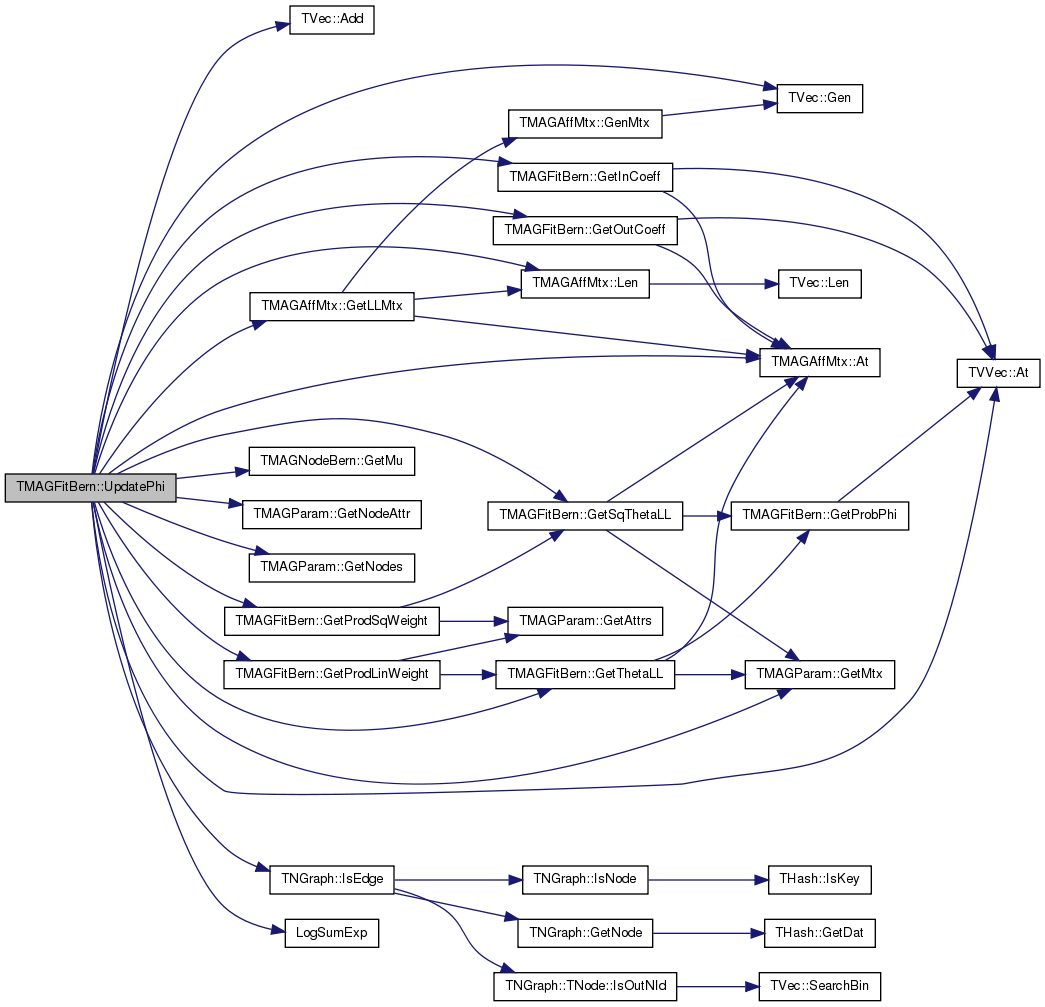
| const double TMAGFitBern::UpdatePhiMI | ( | const double & | Lambda, |
| const int & | NId, | ||
| const int & | AId, | ||
| double & | Phi | ||
| ) |
Definition at line 826 of file mag.cpp.
References TVec< TVal >::Add(), TMAGAffMtx::At(), TVVec< TVal >::At(), TVec< TVal >::Gen(), TMAGParam< TNodeAttr >::GetAttrs(), GetInCoeff(), TMAGAffMtx::GetLLMtx(), TMAGParam< TNodeAttr >::GetMtx(), TMAGNodeBern::GetMu(), TMAGParam< TNodeAttr >::GetNodeAttr(), TMAGParam< TNodeAttr >::GetNodes(), GetOutCoeff(), GetProdLinWeight(), GetProdSqWeight(), GetSqThetaLL(), GetThetaLL(), GradPhiMI(), Graph, IAssert, TNGraph::IsEdge(), TMAGAffMtx::Len(), LogSumExp(), ObjPhiMI(), Param, PhiVV, and TVVec< TVal >::PutAll().
Referenced by DoEStepOneIter().
{
TMAGAffMtx LLTheta, Theta = Param.GetMtx(AId);
TMAGAffMtx SqTheta(Theta);
const int NNodes = Param.GetNodes();
const int NAttrs = Param.GetAttrs();
Theta.GetLLMtx(LLTheta);
TMAGNodeBern DistParam = Param.GetNodeAttr();
const double Mu = DistParam.GetMu(AId);
for(int i = 0; i < Theta.Len(); i++) {
SqTheta.At(i) = SqTheta.At(i) * SqTheta.At(i);
}
// Using log-sum-exp trick
double EdgeQ[2], NonEdgeQ[2], MaxExp[2];
TFltV NonEdgeLLV[2];
TFltVV CntVV(4, NAttrs); CntVV.PutAll(0.0);
for(int i = 0; i < 2; i++) {
EdgeQ[i] = 0.0;
NonEdgeQ[i] = 0.0;
MaxExp[i] = -DBL_MAX;
NonEdgeLLV[i].Gen(4 * NNodes, 0);
}
for(int j = 0; j < NNodes; j++) {
if(j == NId) { continue; }
for(int l = 0; l < NAttrs; l++) {
if(l == AId) { continue; }
CntVV(0, l) = CntVV(0, l) + PhiVV(j, AId) * PhiVV(j, l);
CntVV(1, l) = CntVV(1, l) + PhiVV(j, AId) * (1.0-PhiVV(j, l));
CntVV(2, l) = CntVV(2, l) + (1.0-PhiVV(j, AId)) * PhiVV(j, l);
CntVV(3, l) = CntVV(3, l) + (1.0-PhiVV(j, AId)) * (1.0-PhiVV(j, l));
}
if(Graph->IsEdge(NId, j)) {
EdgeQ[0] += GetOutCoeff(NId, j, AId, 0, LLTheta);
EdgeQ[1] += GetOutCoeff(NId, j, AId, 1, LLTheta);
} else {
double LinW = GetProdLinWeight(NId, j) - GetThetaLL(NId, j, AId);
double SqW = GetProdSqWeight(NId, j) - GetSqThetaLL(NId, j, AId);
for(int i = 0; i < 2; i++) {
NonEdgeLLV[i].Add(LinW + log(GetOutCoeff(NId, j, AId, i, Theta)));
NonEdgeLLV[i].Add(SqW + log(GetOutCoeff(NId, j, AId, i, SqTheta)) + log(0.5));
}
}
if(Graph->IsEdge(j, NId)) {
EdgeQ[0] += GetInCoeff(j, NId, AId, 0, LLTheta);
EdgeQ[1] += GetInCoeff(j, NId, AId, 1, LLTheta);
} else {
double LinW = GetProdLinWeight(j, NId) - GetThetaLL(j, NId, AId);
double SqW = GetProdSqWeight(j, NId) - GetSqThetaLL(j, NId, AId);
for(int i = 0; i < 2; i++) {
NonEdgeLLV[i].Add(LinW + log(GetInCoeff(j, NId, AId, i, Theta)));
NonEdgeLLV[i].Add(SqW + log(GetInCoeff(j, NId, AId, i, SqTheta)) + log(0.5));
}
}
}
NonEdgeQ[0] = LogSumExp(NonEdgeLLV[0]);
NonEdgeQ[1] = LogSumExp(NonEdgeLLV[1]);
double Q[2];
Q[0] = log(Mu) + EdgeQ[0] - exp(NonEdgeQ[0]);
Q[1] = log(1.0 - Mu) + EdgeQ[1] - exp(NonEdgeQ[1]);
double DeltaQ = Q[0] - Q[1];
// double x[] = {0.1, 0.3, 0.5, 0.7, 0.9};
double x[] = {PhiVV(NId, AId)};
// for(int n = 0; n < 5; n++) {
for(int n = 0; n < 1; n++) {
// double LrnRate = 0.0002;
double LrnRate = 0.001;
for(int step = 0; step < 200; step++) {
double Grad = GradPhiMI(x[n], NId, AId, Lambda, DeltaQ, CntVV);
if(Grad > 0.0) { x[n] += LrnRate; }
else { x[n] -= LrnRate; }
if(x[n] > 0.9999) { x[n] = 0.9999; }
if(x[n] < 0.0001) { x[n] = 0.0001; }
LrnRate *= 0.995;
}
}
double MaxVal = -DBL_MAX;
int MaxX = -1;
// for(int n = 0; n < 5; n++) {
for(int n = 0; n < 1; n++) {
double Val = ObjPhiMI(x[n], NId, AId, Lambda, Q[0], Q[1], CntVV);
if(Val > MaxVal) {
MaxVal = Val;
MaxX = n;
}
}
IAssert(MaxX >= 0);
Phi = x[MaxX];
return Phi - PhiVV.At(NId, AId);
}
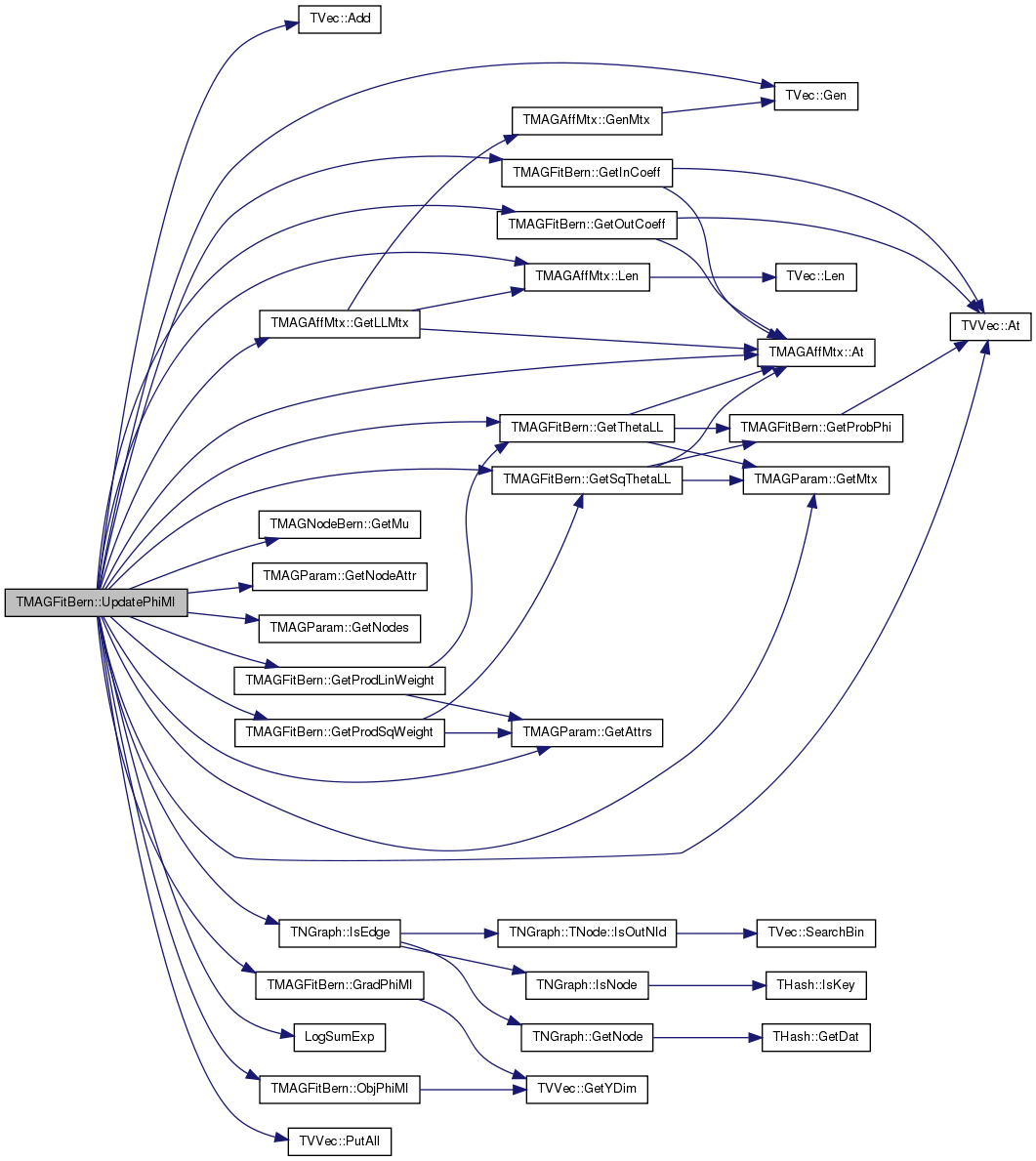

TFltVV TMAGFitBern::AvgPhiPairVV [private] |
Definition at line 349 of file mag.h.
Referenced by DoEStepApxOneIter(), TMAGFitBern(), and UpdateApxPhiMI().
TFltV TMAGFitBern::AvgPhiV [private] |
Definition at line 348 of file mag.h.
Referenced by DoEStepApxOneIter(), DoMStep(), GetAvgInCoeff(), GetAvgOutCoeff(), GetProbMu(), NormalizeAffMtxV(), TMAGFitBern(), and UpdateMu().
bool TMAGFitBern::Debug [private] |
Definition at line 347 of file mag.h.
Referenced by DoEMAlg(), and SetDebug().
bool TMAGFitBern::ESpeedUp [private] |
Definition at line 347 of file mag.h.
Referenced by DoEStep(), and SetAlgConf().
PNGraph TMAGFitBern::Graph [private] |
Definition at line 345 of file mag.h.
Referenced by ComputeApxAdjLL(), ComputeApxLL(), ComputeJointAdjLL(), ComputeJointOneLL(), GetGraph(), GradAffMtx(), GradApxAffMtx(), NormalizeAffMtxV(), PlotProperties(), SetGraph(), UnNormalizeAffMtxV(), UpdateApxPhiMI(), UpdatePhi(), and UpdatePhiMI().
TBoolVV TMAGFitBern::KnownVV [private] |
Definition at line 344 of file mag.h.
Referenced by Clr(), DoEMAlg(), DoEStepApxOneIter(), DoEStepOneIter(), Init(), RandomInit(), SetPhiVV(), and TMAGFitBern().
TFltV TMAGFitBern::LLHisV [private] |
bool TMAGFitBern::MSpeedUp [private] |
Definition at line 347 of file mag.h.
Referenced by SetAlgConf(), UpdateAffMtx(), and UpdateAffMtxV().
TVec<TMAGAffMtxV> TMAGFitBern::MtxHisV [private] |
TVec<TFltV> TMAGFitBern::MuHisV [private] |
TFlt TMAGFitBern::NormConst [private] |
Definition at line 350 of file mag.h.
Referenced by ComputeApxLL(), DoEMAlg(), GetAvgProdLinWeight(), GetAvgProdSqWeight(), GetProdLinWeight(), GetProdSqWeight(), NormalizeAffMtxV(), and UnNormalizeAffMtxV().
TMAGParam<TMAGNodeBern> TMAGFitBern::Param [private] |
Definition at line 346 of file mag.h.
Referenced by ComputeApxAdjLL(), ComputeApxLL(), ComputeJointAdjLL(), ComputeJointLL(), ComputeJointOneLL(), DoEMAlg(), DoEStep(), DoEStepApxOneIter(), DoEStepOneIter(), DoMStep(), GetAttrs(), GetAvgInCoeff(), GetAvgOutCoeff(), GetAvgProdLinWeight(), GetAvgProdSqWeight(), GetAvgSqThetaLL(), GetAvgThetaLL(), GetEstNoEdgeLL(), GetMtxV(), GetMuV(), GetNodeAttr(), GetNodes(), GetParams(), GetProbMu(), GetProdLinWeight(), GetProdSqWeight(), GetSqThetaLL(), GetThetaLL(), GradAffMtx(), GradApxAffMtx(), Init(), NormalizeAffMtxV(), PlotProperties(), PrepareUpdateAffMtx(), PrepareUpdateApxAffMtx(), RandomInit(), SaveTxt(), SetMtxV(), SetMuV(), SetPhiVV(), TMAGFitBern(), UnNormalizeAffMtxV(), UpdateAffMtx(), UpdateAffMtxV(), UpdateApxPhiMI(), UpdateMu(), UpdatePhi(), and UpdatePhiMI().
TFltVV TMAGFitBern::PhiVV [private] |
Definition at line 343 of file mag.h.
Referenced by Clr(), ComputeApxAdjLL(), ComputeApxLL(), ComputeJointLL(), CountAttr(), DoEMAlg(), DoEStepApxOneIter(), DoEStepOneIter(), GetInCoeff(), GetOutCoeff(), GetPhiVV(), GetProbMu(), GetProbPhi(), GradPhiMI(), Init(), ObjPhiMI(), PlotProperties(), RandomInit(), SaveTxt(), SetPhiVV(), TMAGFitBern(), UpdateApxPhiMI(), UpdateMu(), UpdatePhi(), and UpdatePhiMI().